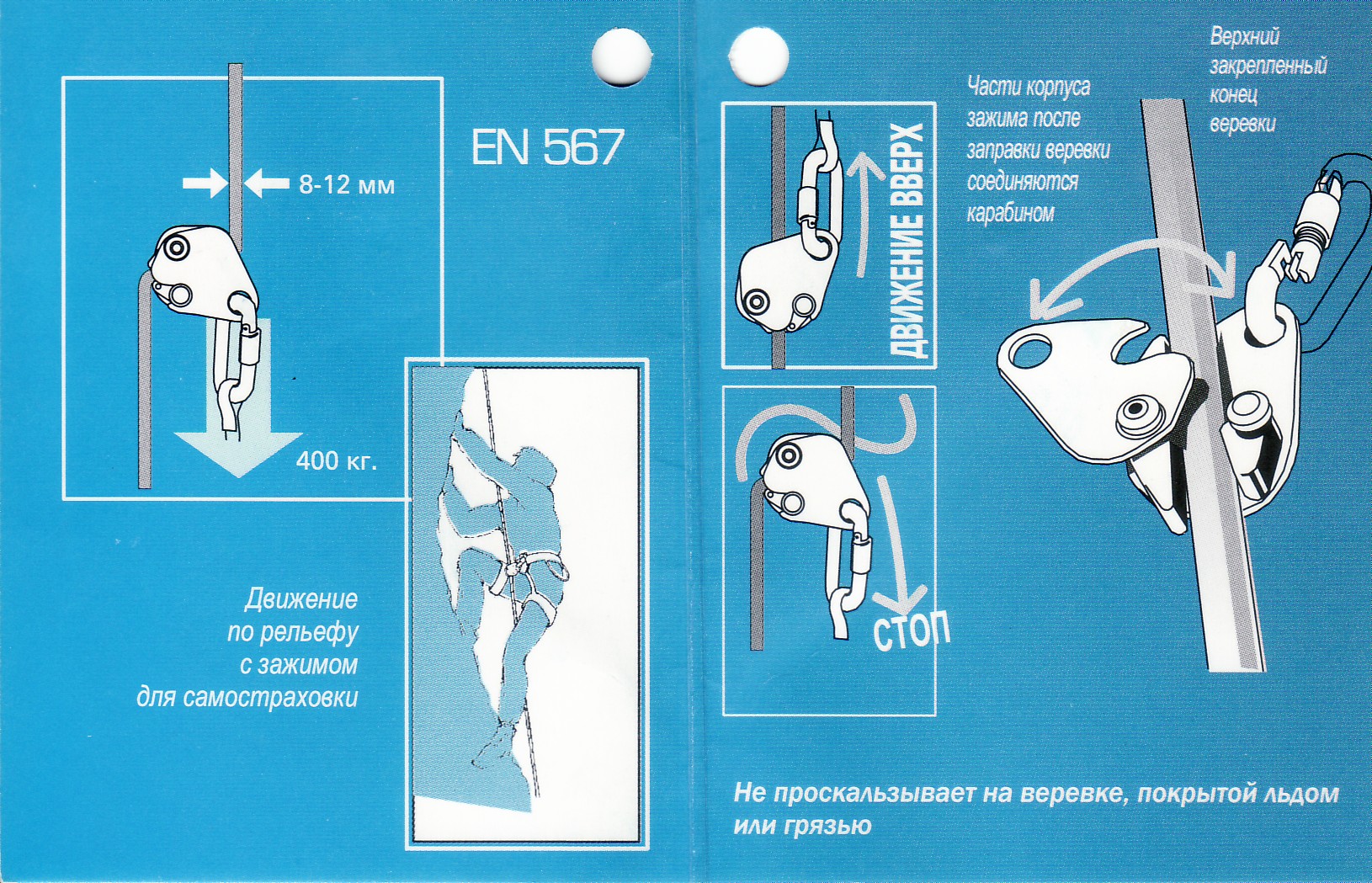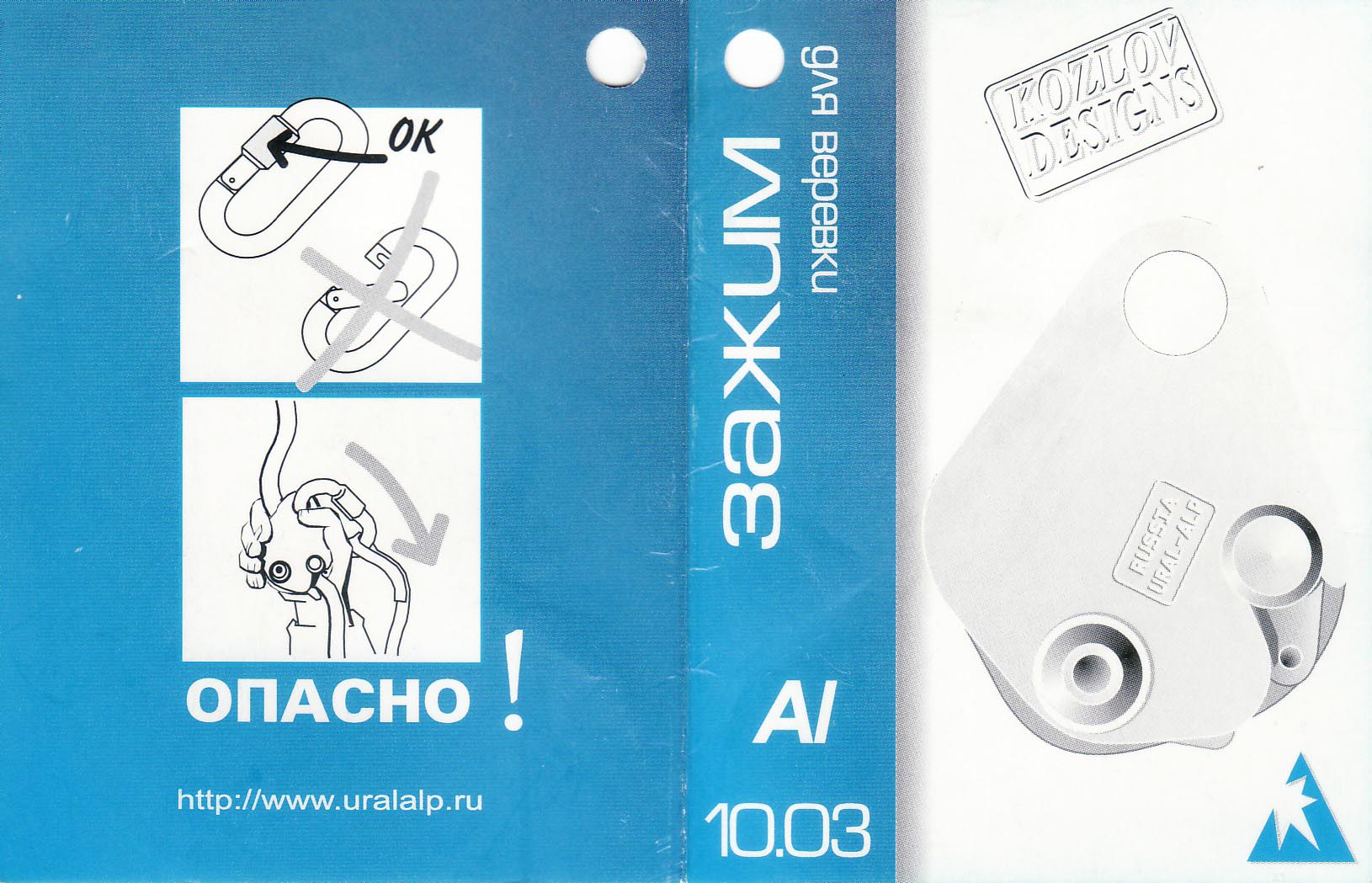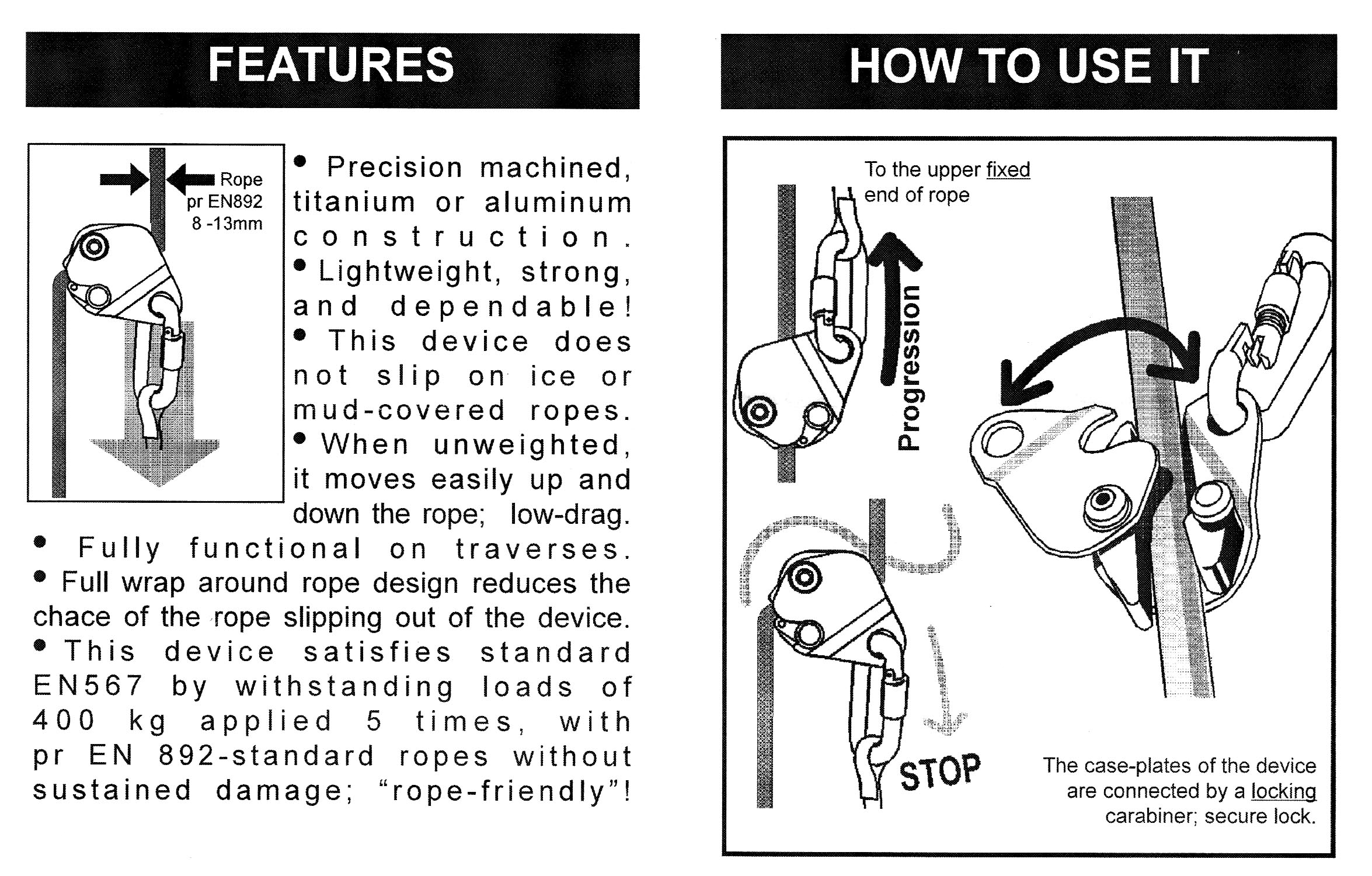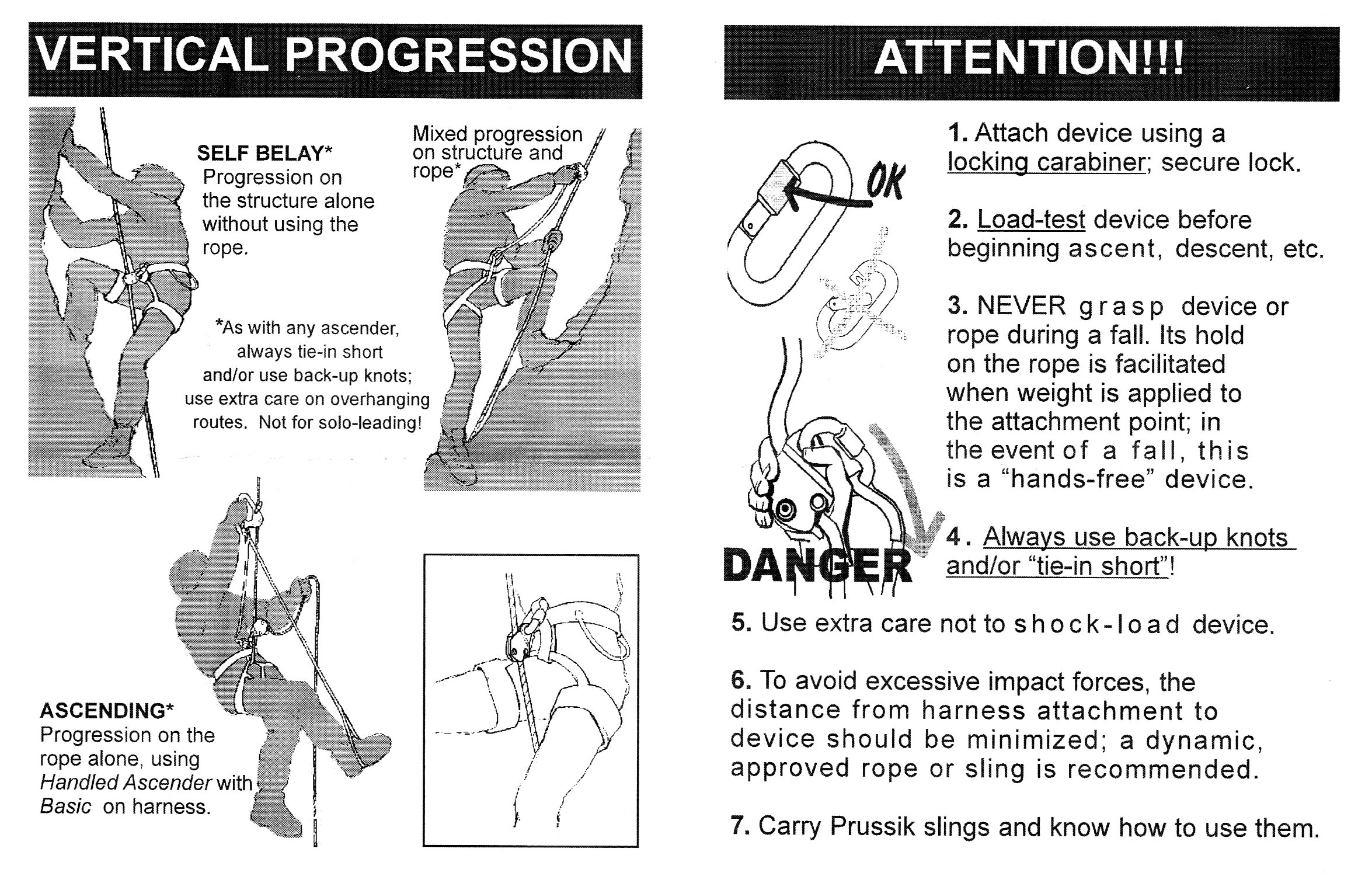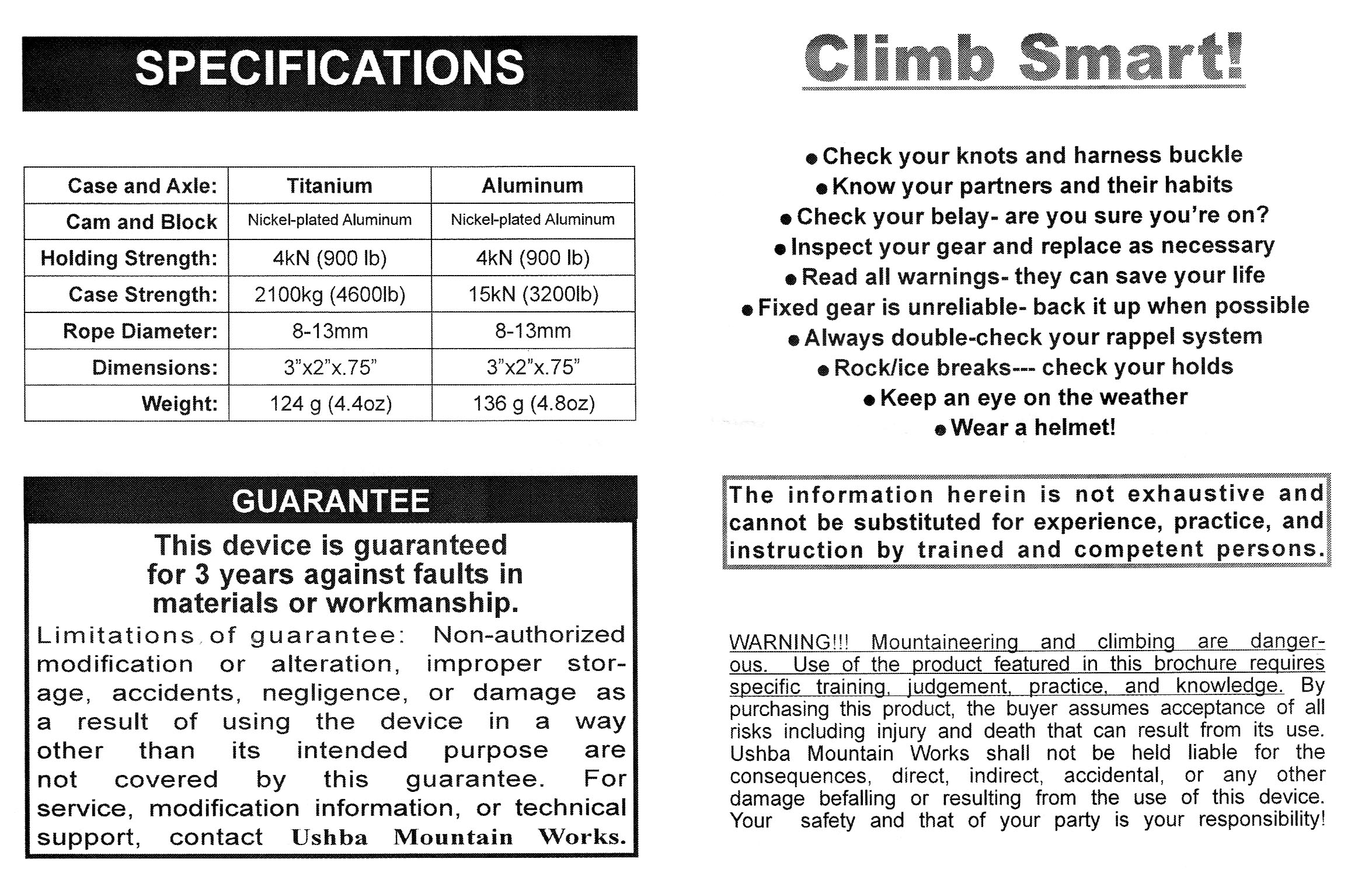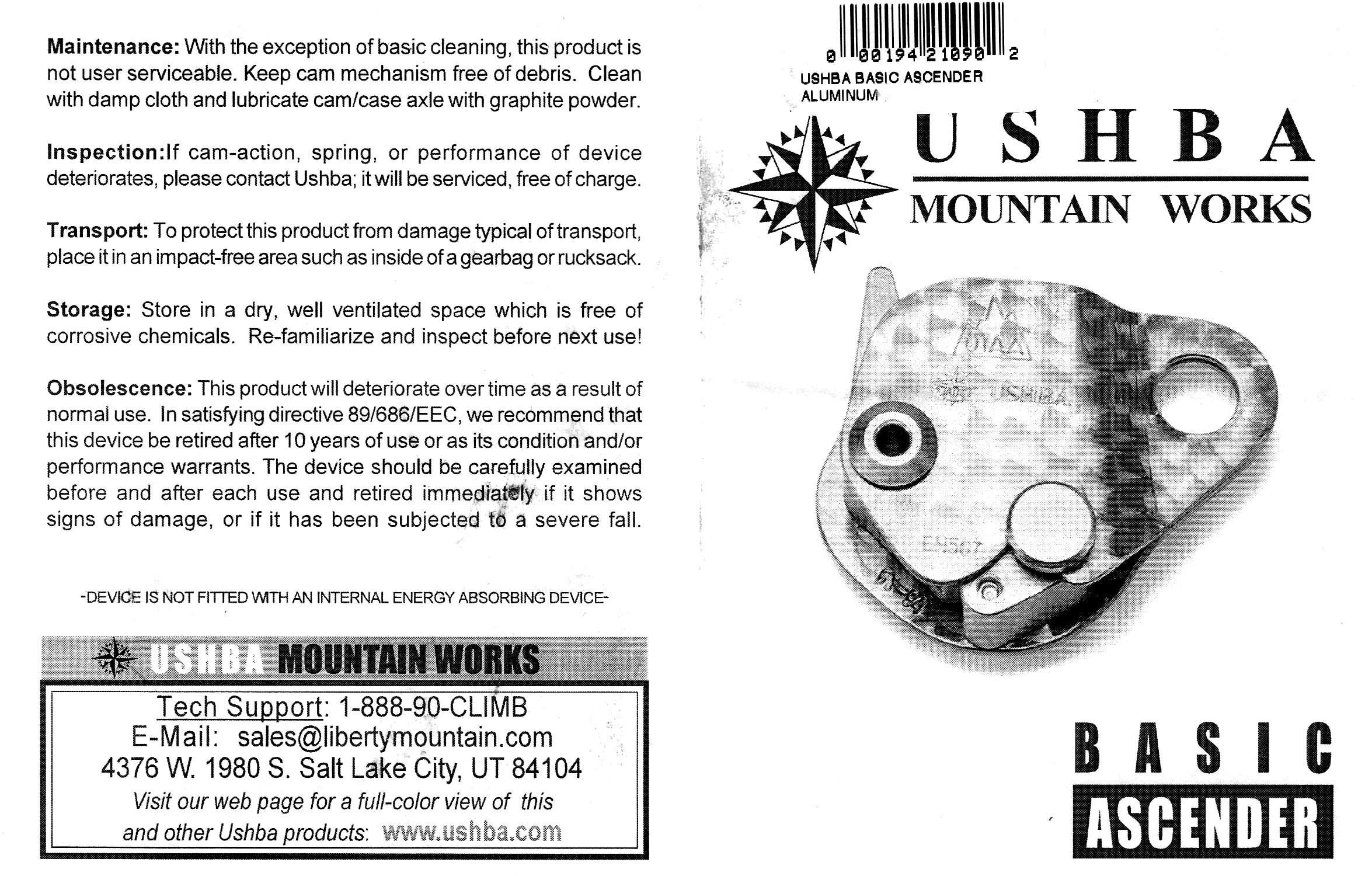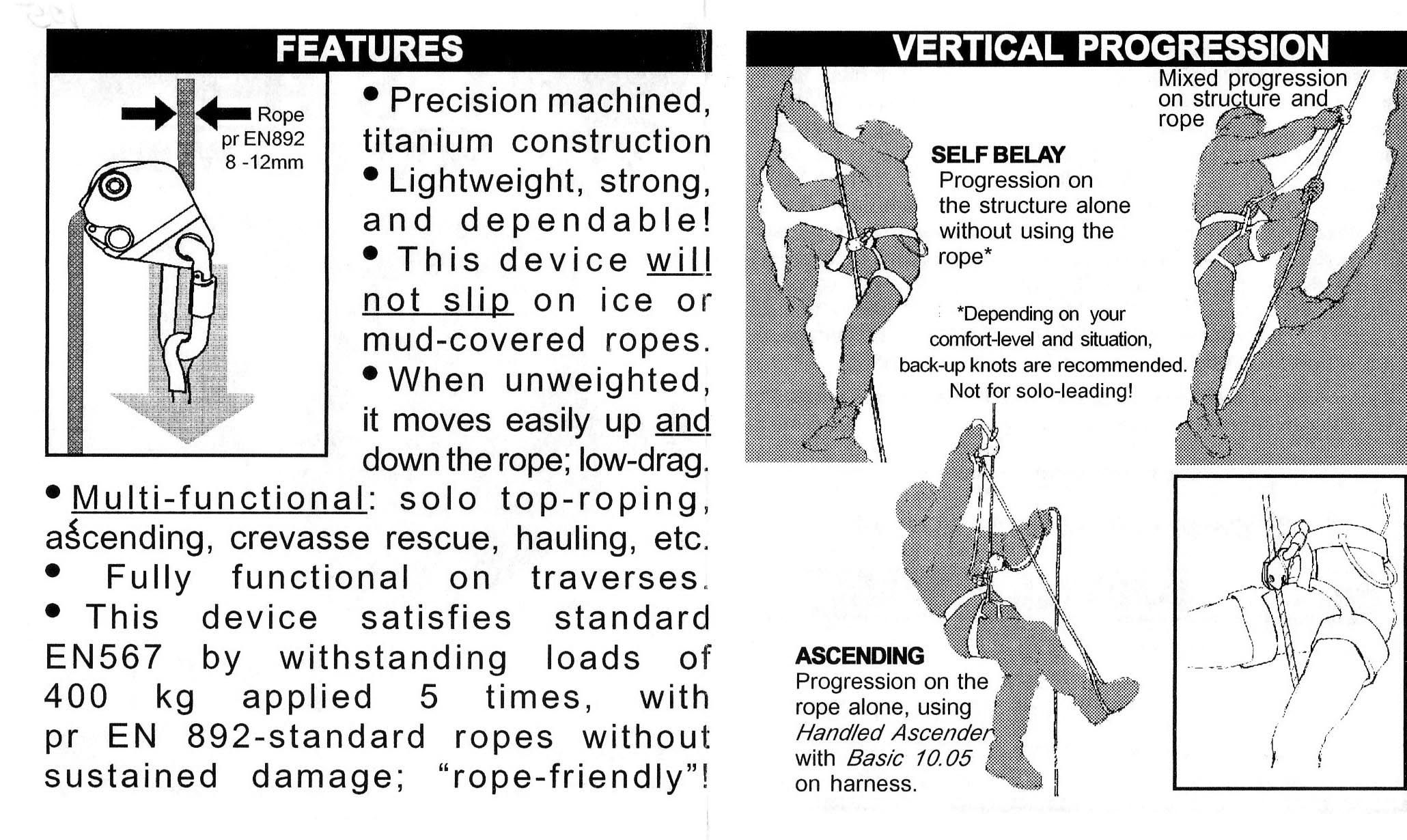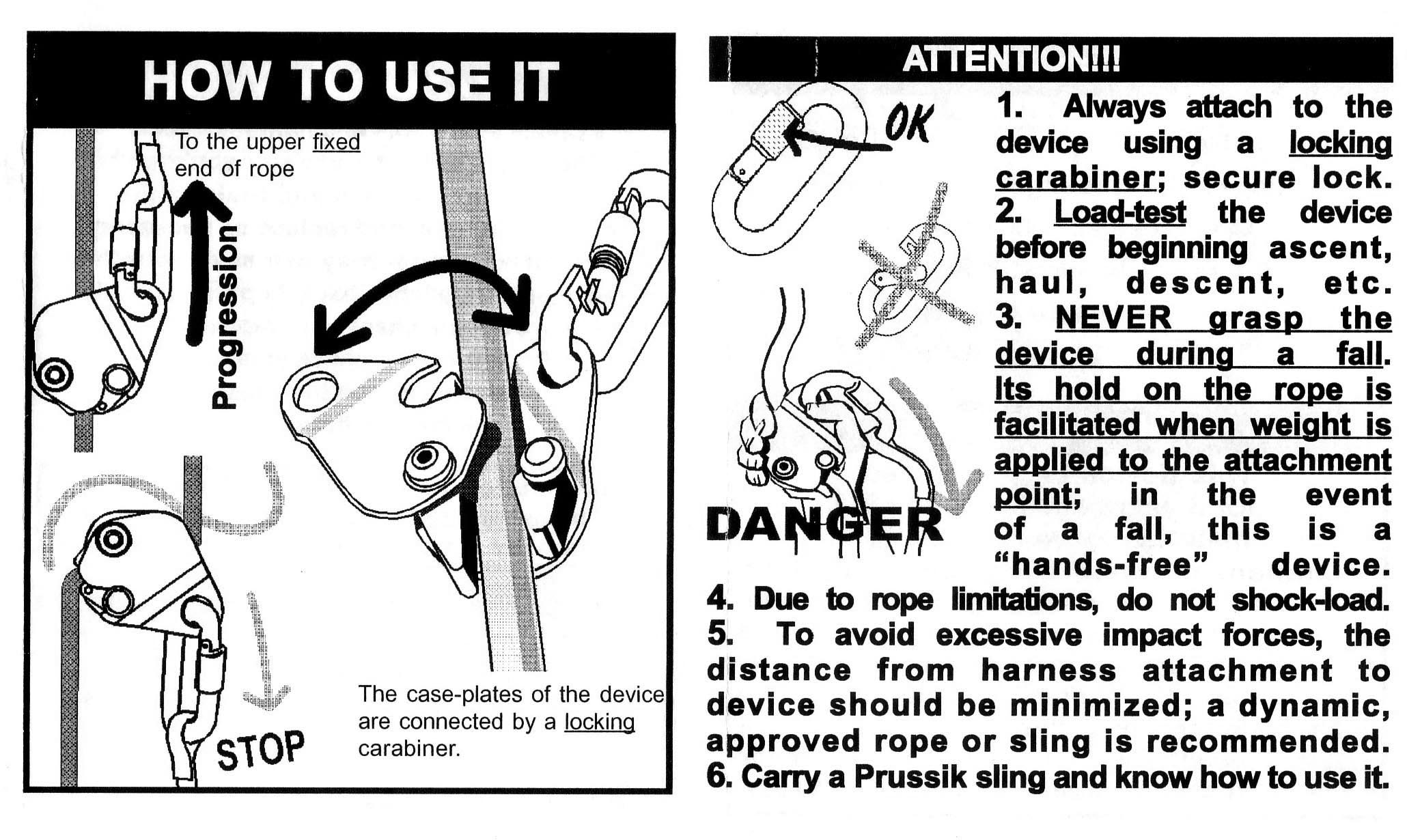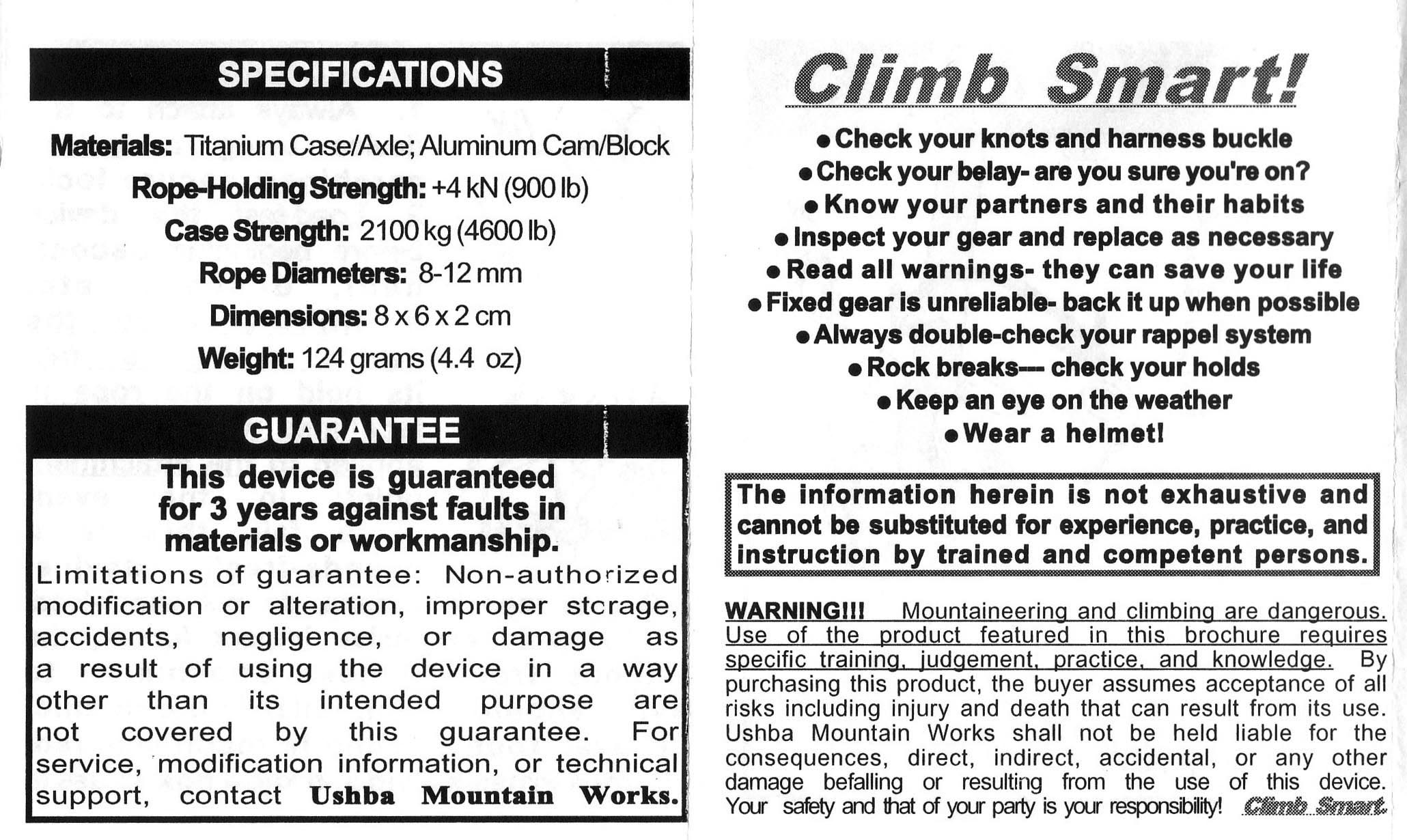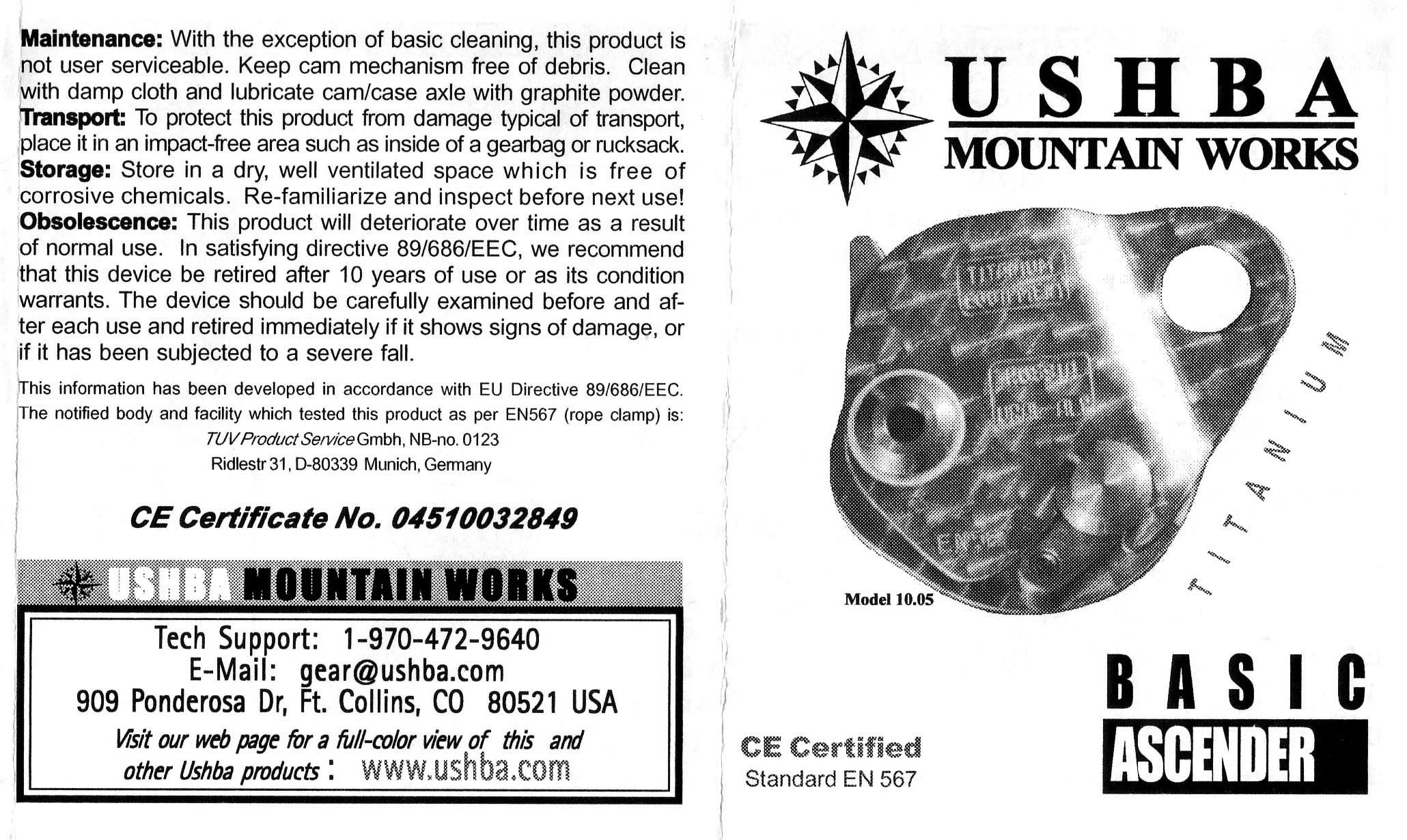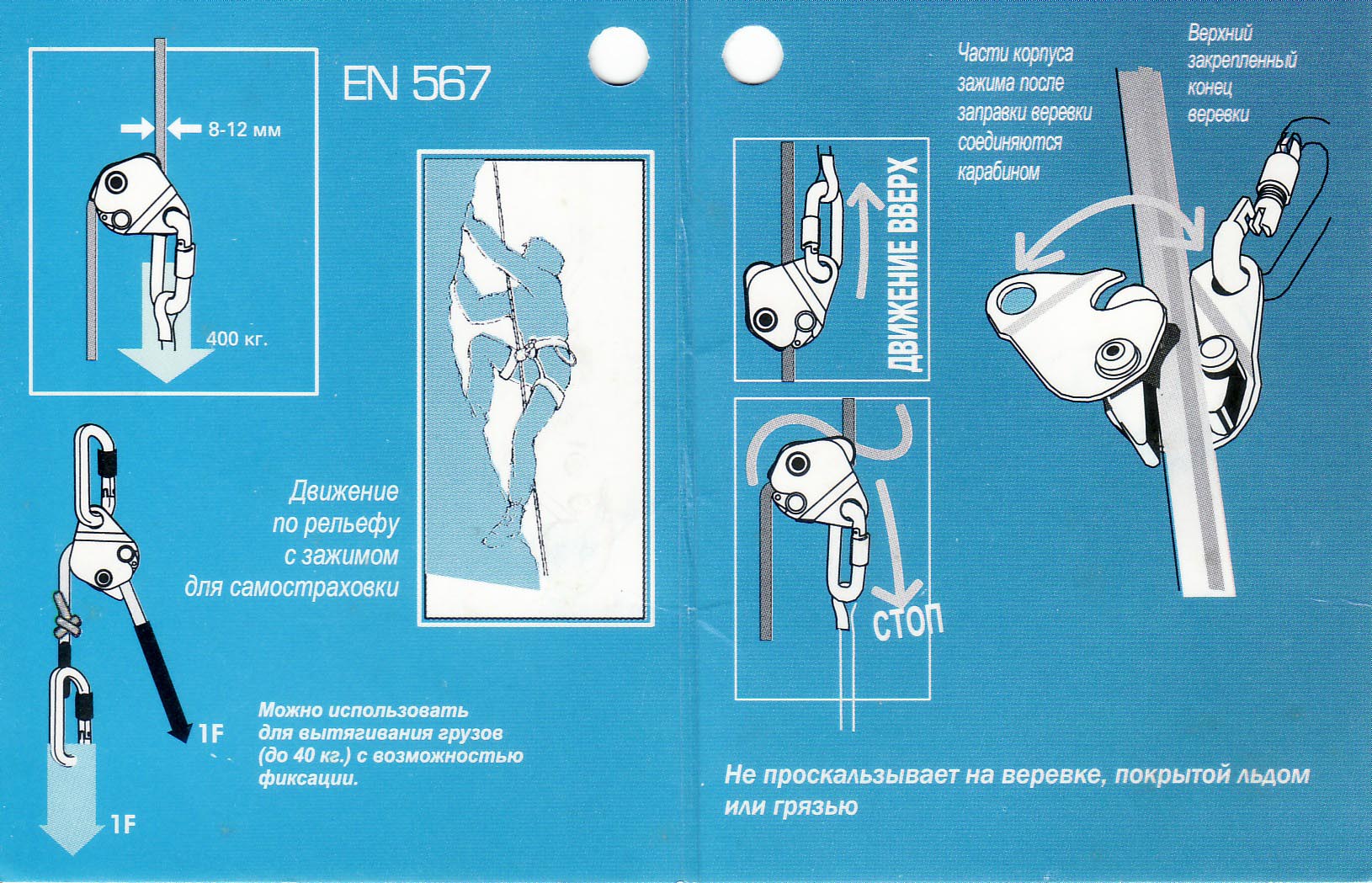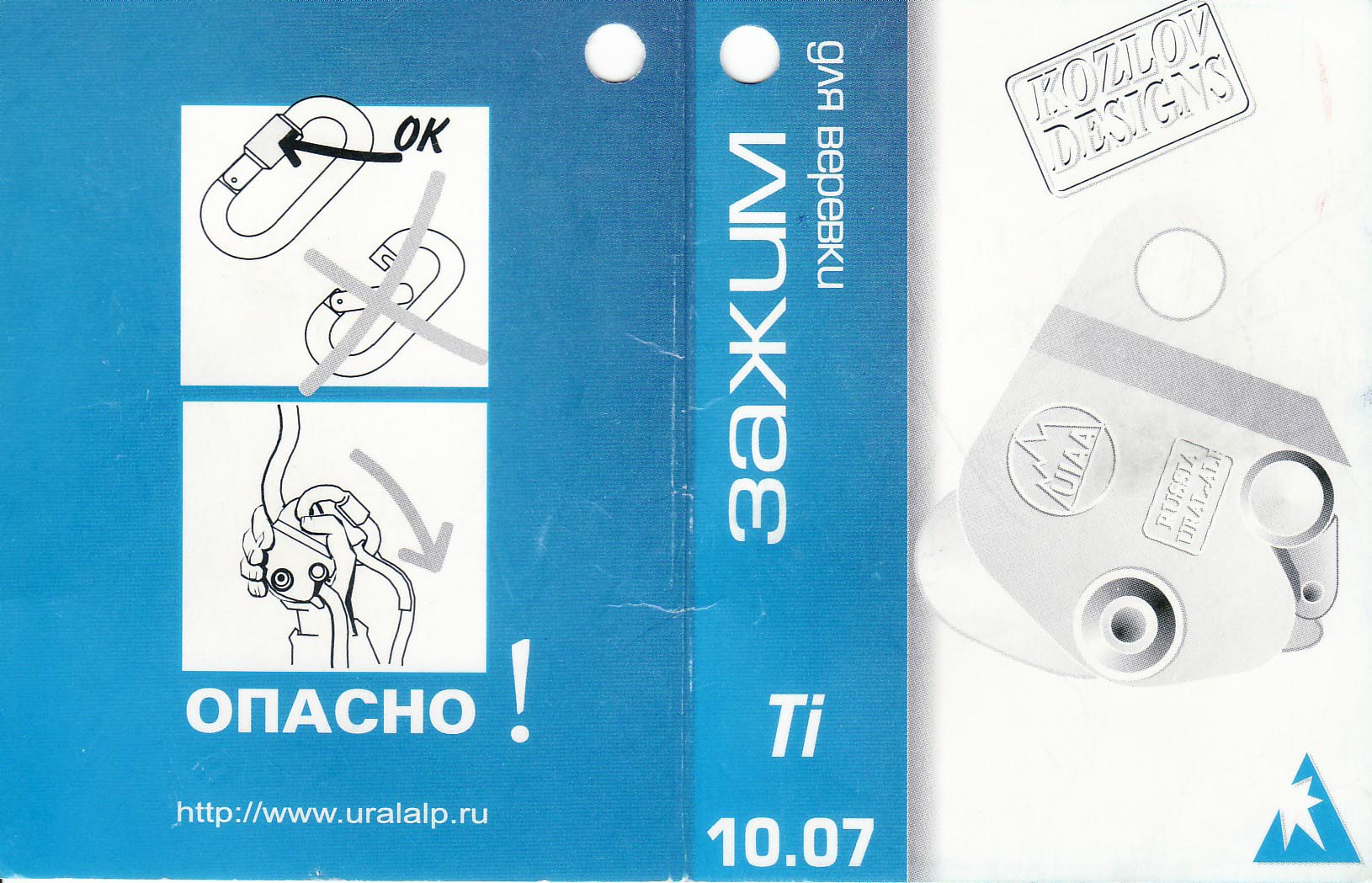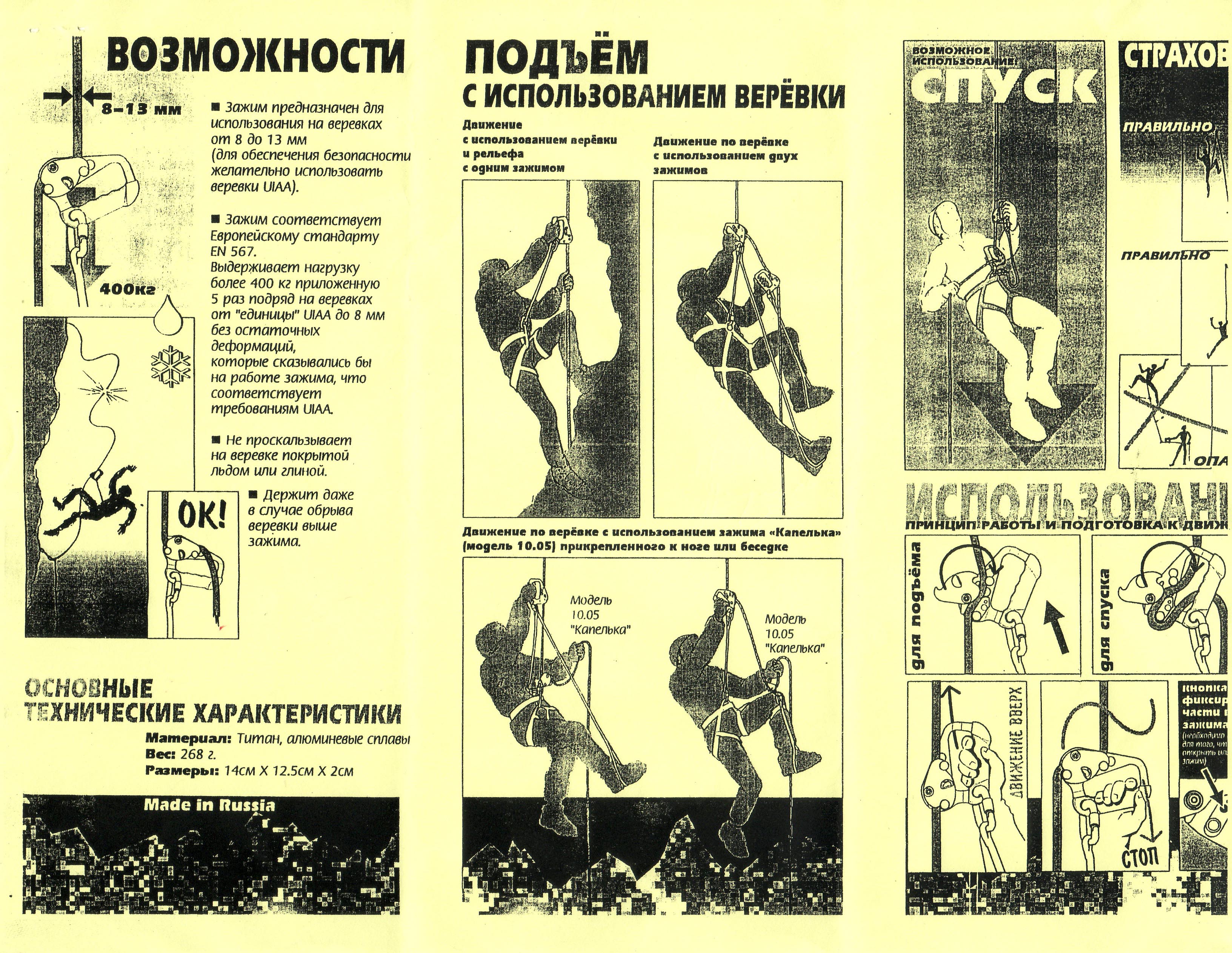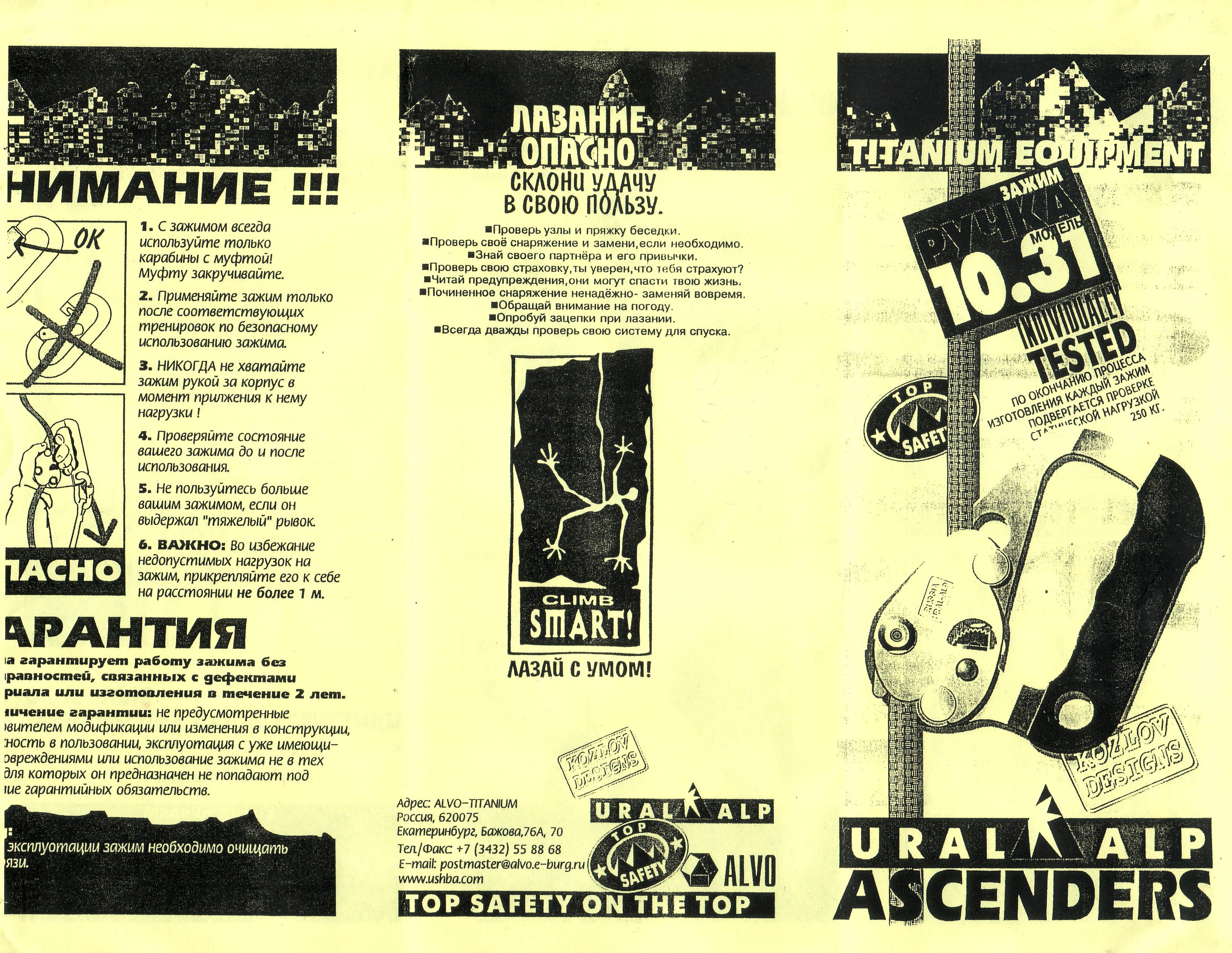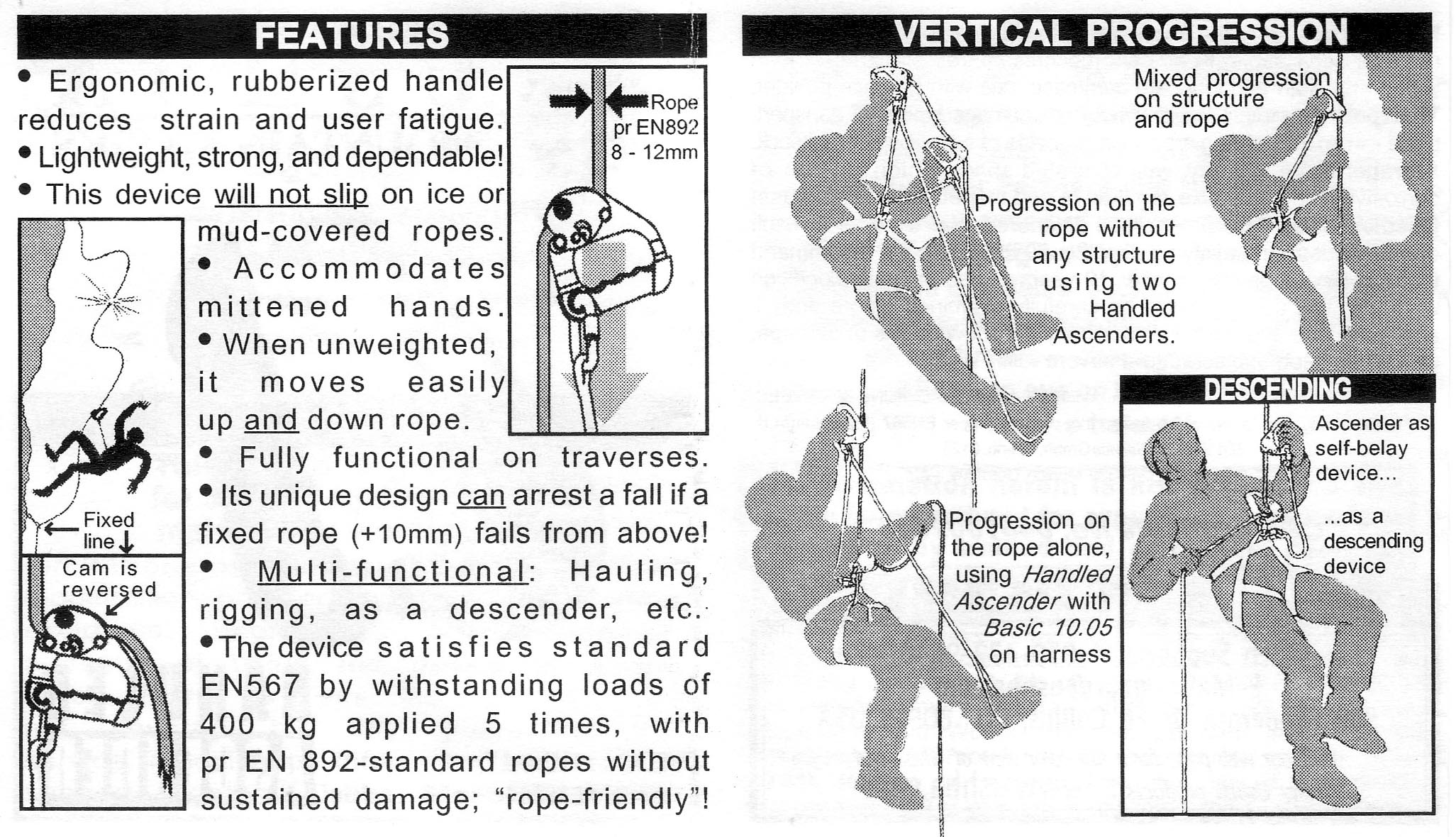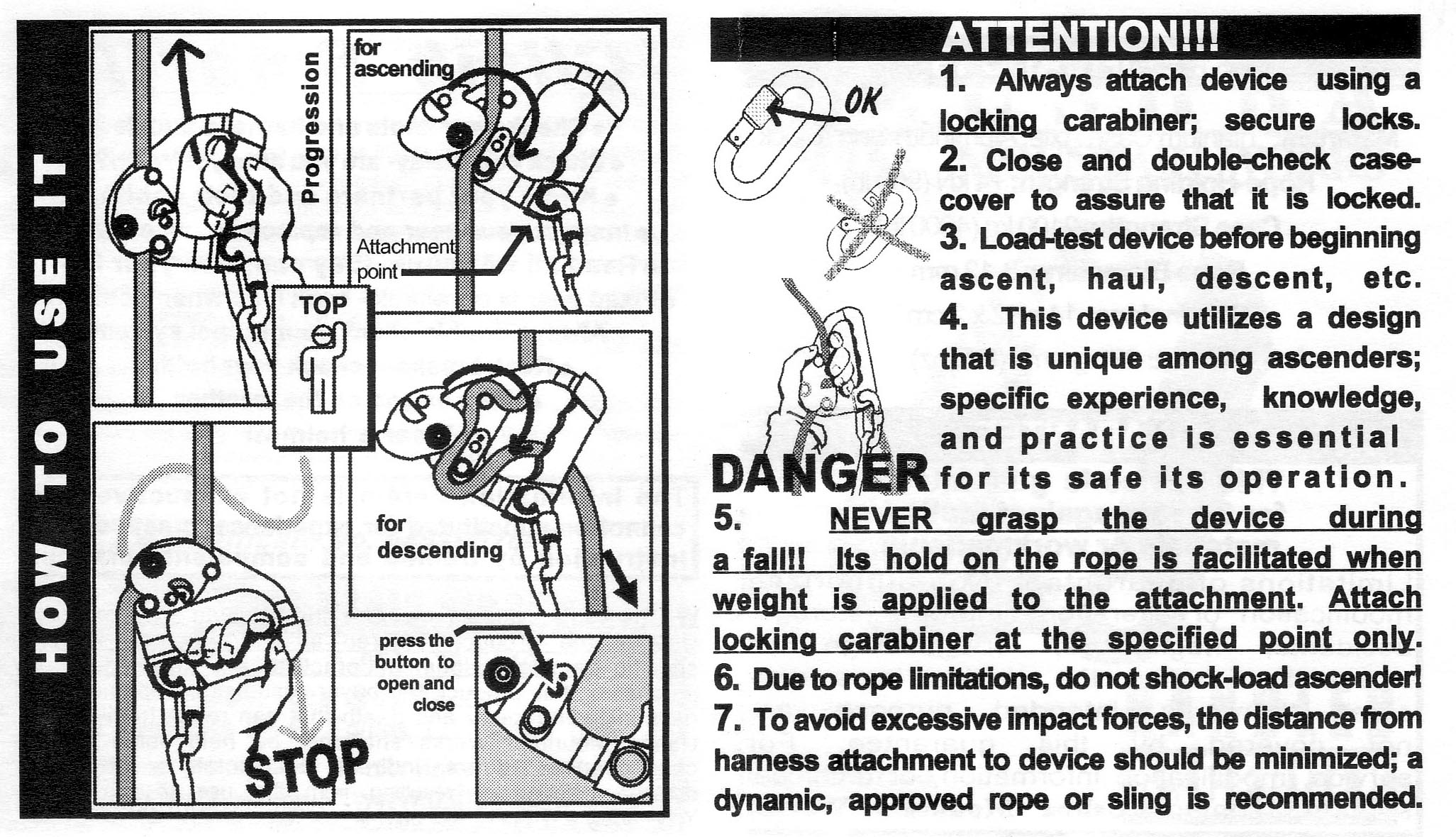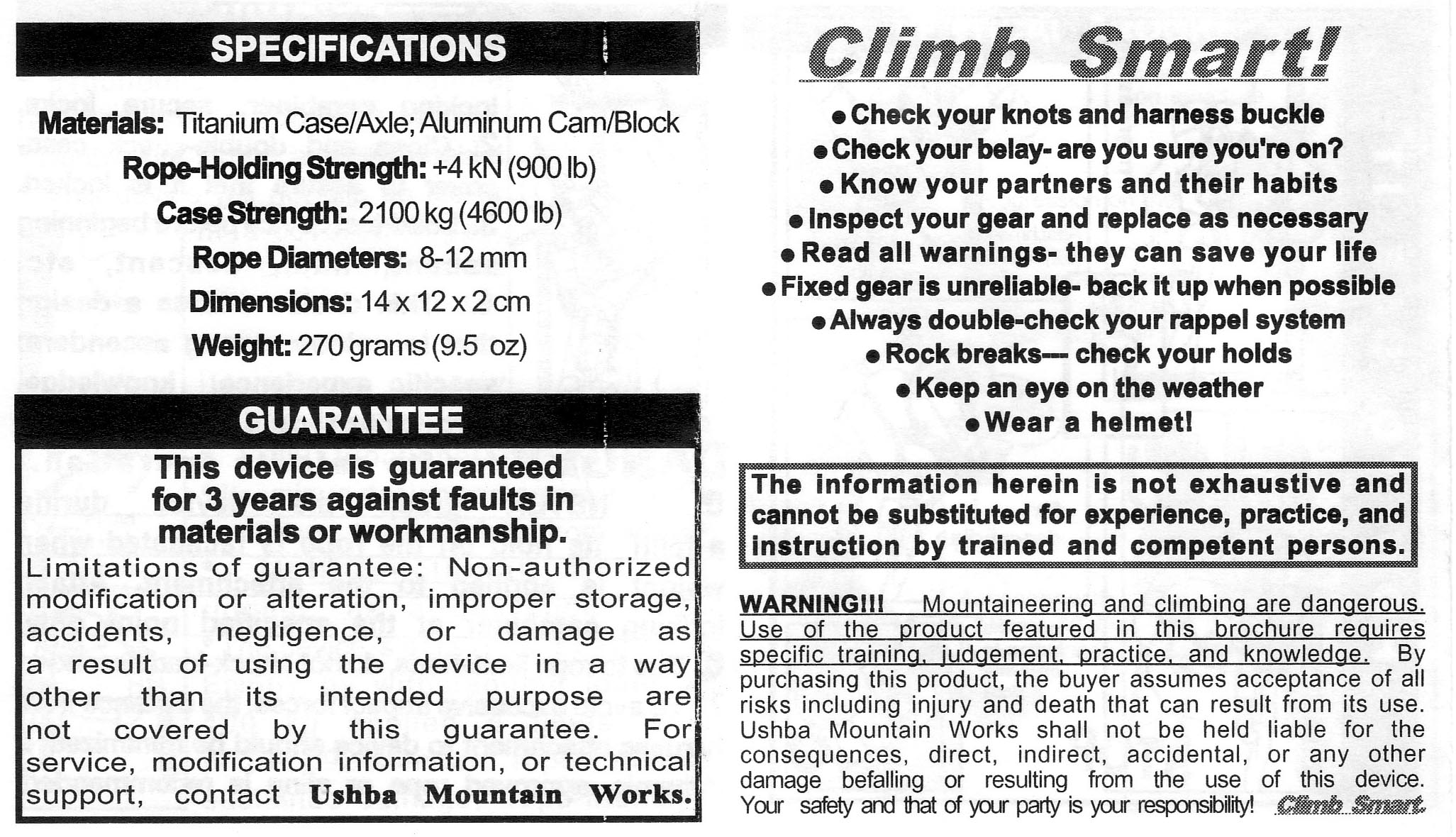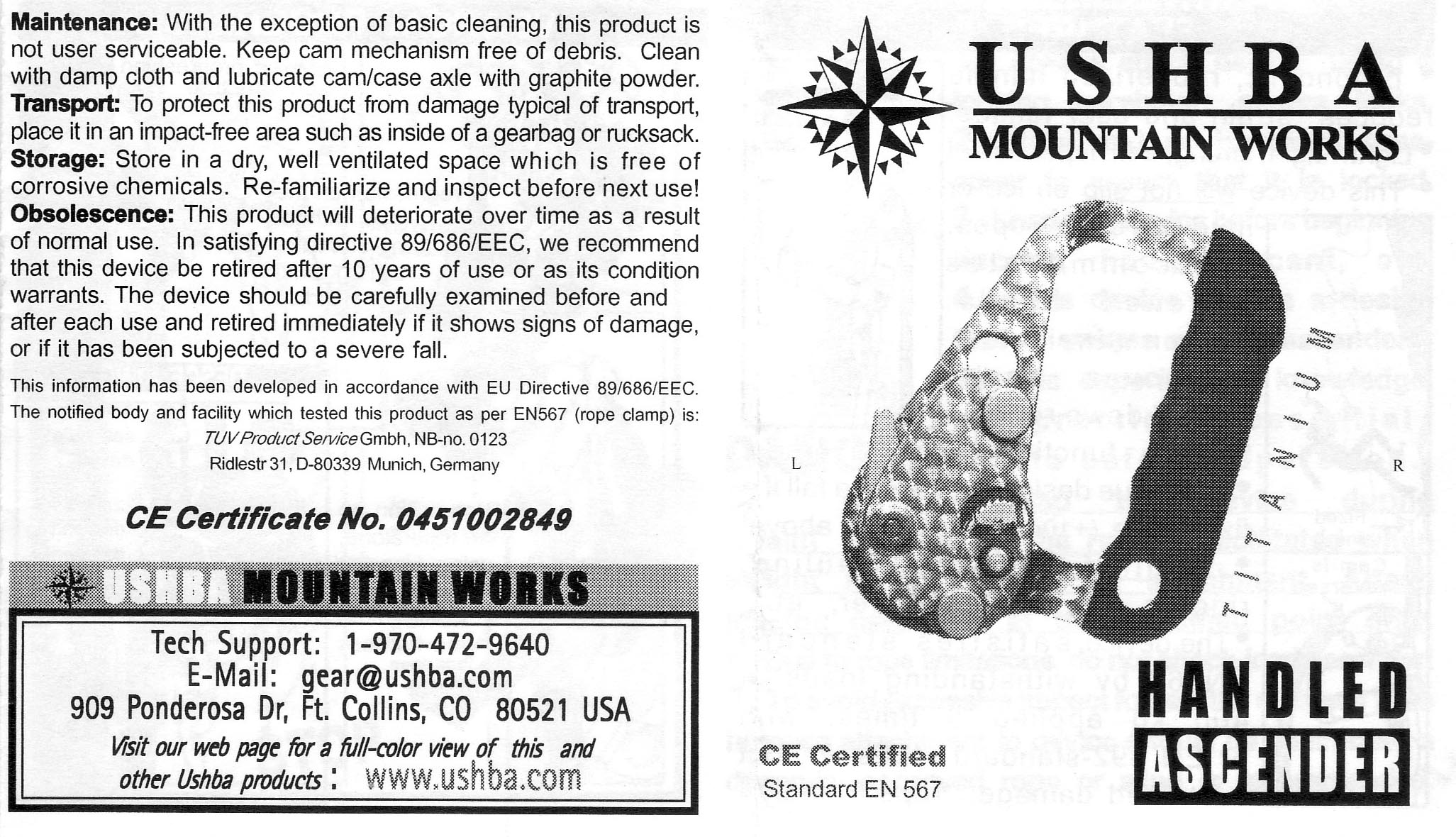Overview
Ushba Mountain Works was an American distributor for Ural Alp products.
I see no reason to keep them separate, and so I combined their ascenders with Ural Alp’s on this page.
[ Top
| Al Basic 10.03
| Basic 10.04
| Basic 10.05, v. A
| Basic 10.05, v. B
| Basic 10.05, v. C
| Basic 10.05, v. D
| Basic 10.05, v. E
| Basic 10.05, v. F
|
| Basic K
| Super Basic, v. A
| Super Basic, v. B
| Super Basic K
| Steel Basic
| Ural Alp Handled
| Ushba Handled, v. A
| Ushba Handled, v. B
| Return to Rocker-Arm Ascenders
| Ushba Handled, v. B
]
Ural Alp Aluminum Basic 10.03
(#191)
Technical Details
I acquired my Ural Alp Al Basic 10.03 from Ural Sport in 2005.
The Al Basic 10.03 is 92 mm. tall, 75 mm. wide, 31 mm. thick, and weighs 137 g.
The primary difference between the 10.03 and the basic is the
side plate material: the 10.03 uses 4 mm. aluminum.
The front plate on my 10.03 is stamped with a rectangle containing
"RUSSIA" and URAL-ALP." The outside of the rear
plate is stamped with "Made in Russia" and a rectangle
containing the words "KOZLOV DESIGNS." The inside of
the rear plate is stamped with "▲," "ROPE," "Ø10-12MM" and "▼."
Like the Basic, the 10.03 is well-made. All surfaces are nicely
rounded. The 10.03 is slightly larger and heavier than the basic,
but many people would not notice the difference. Unfortunately,
the 10.03’s aluminum shell does not look as nice as the
engine ruled titanium on other models.
[ Top
| Ural-Alp Al Basic 10.03
| Basic 10.04
| Basic 10.05, v. A
| Basic 10.05, v. B
| Basic 10.05, v. C
| Basic 10.05, v. D
| Basic 10.05, v. E
| Basic 10.05, v. F
|
| Basic K
| Super Basic, v. A
| Super Basic, v. B
| Super Basic K
| Steel Basic
| Ural Alp Handled
| Ushba Handled, v. A
| Ushba Handled, v. B
| Return to Rocker-Arm Ascenders
| Ushba Handled, v. B
]
Ushba Aluminum Basic 10.03
(#232, 2275)
Technical Details
I acquired my Ushba Al Basic 10.03 from Mountainland Outdoor in
2007.
The Ushba Al Basic 10.03 is 93 mm. tall, 75 mm. wide, 33 mm. thick, and weighs 141 g.
The primary difference between this version and the Ural-Alp version is that the Ushba has a 6.3 mm. hole in the rear plate, just outside
the anvil.
The front plate on my Ushba 10.03 is stamped with the Ushba
logo. The outside of the rear plate is stamped with "Made
in Russia" and a rectangle containing the words "KOZLOV
DESIGNS." The inside of the rear plate is stamped with "▲," "ROPE," "Ø10-12
MM" and "▼."
Like the previous version, this one is well-made - after all, they are essentially
the same ascender.
[ Top
| Ural-Alp Al Basic 10.03
| Al Basic 10.03
| Basic 10.05, v. A
| Basic 10.05, v. B
| Basic 10.05, v. D
| Basic 10.05, v. E
| Basic 10.05, v. F
| Basic 10.05, v. C
| Basic 10.05, v. F
|
| Basic K
| Super Basic, v. A
| Super Basic, v. B
| Super Basic K
| Steel Basic
| Ural Alp Handled
| Ushba Handled, v. A
| Ushba Handled, v. B
| Return to Rocker-Arm Ascenders
| Ushba Handled, v. B
]
Ural Alp Aluminum Basic 10.04
(#2375)
Technical Details
I acquired my Ural Alp Basic 10.04 from Marina Khramstova (Марина Храмцова) in 2019.
The Ural Alp Basic 10.04 is 93 mm. tall, 82 mm. wide, 33 mm. thick, and weighs 156 g.
The 10.04 has a different cam than the 10.03. It is thicker and the ends have both a larger radius and a concave U-channel to guide the rope. There are two lightening holed in the cam.
The front plate on my 10.04 is stamped with a rectangle containing
"RUSSIA" and "URAL-ALP." The outside of the rear
plate is stamped with "KOZLOV DESIGNS" and "Made in Russia." The inside of
the rear plate has a sticker saying "ROPE 10-12 mm."
Like the previous version, this one is well-made.
The new cam makes this ascender 20 g. heavier than the 10.03, but the larger radii are easier on the rope than the small-radius corners on the 10.03 cam.
[ Top
| Ural-Alp Al Basic 10.03
| Al Basic 10.03
| Basic 10.04
| Basic 10.05, v. B
| Basic 10.05, v. C
| Basic 10.05, v. D
| Basic 10.05, v. E
| Basic 10.05, v. F
|
| Basic K
| Super Basic, v. A
| Super Basic, v. B
| Super Basic K
| Steel Basic
| Ural Alp Handled
| Ushba Handled, v. A
| Ushba Handled, v. B
| Return to Rocker-Arm Ascenders
| Ushba Handled, v. B
]
Ural-Alp Basic 10.05, Version A
(#105, 2071)
Technical Details
I acquired my Basic, Version A from John E. Weinel, Inc. in 1994. I acquired another in 2017 as part of Bob Thrun’s collection.
This ascender is 71 mm. tall, 86 mm. wide, 27 mm. thick, and weighs 126 g.
Version A consists of two pear-shaped plates of engine-ruled
titanium enclosing an actuating lever and a rope anvil. Each side
plate has a 15 mm. attachment hole at the right side of the
ascender. A 6 mm. bolt on the left side supports the actuating
lever. The stainless steel axle bolt passes from front to back,
passing in sequence through a nylon washer, the front side plate
(free to rotate), a second nylon washer, the actuation lever,
a third nylon washer, the rear plate (held tightly), a stainless
steel washer, and a stainless steel nut. The nut is staked in
place with two center punch marks. The bolt axis is drilled for
60% of its length to reduce weight. The actuating lever is spring-loaded
counter-clockwise, toward the anvil. The left side of the lever
has cutouts to reduce weight, while the right side, which contacts
the rope, is flat. A 6 mm. special bolt attaches an anvil to the
lower part of the rear plate. A groove in this bolt engages a
notch in the front plate. A 3 mm. countersunk rivet prevents
anvil rotation. The left side (rope face) of the anvil has a shallow
U-shaped groove milled in it.
The front plate is stamped with the UIAA logo and a circle
containing "URAL-ALP," and "TITANIUM EQUIPMENT."
The outside of the rear plate is stamped with a rectangle also
containing the words "TITANIUM EQUIPMENT." The inside
of the rear plate is stamped with the Sieg
Heil icon, a circle containing "ROPE OR HAWSER Ø6-13
MM" and the numbers "62-94."
This
ascender is similar to the Russian
ascender described on a previous page, but it is much better
made. To start with, the side plates are made from thicker Titanium
sheet, and have a beautiful engine turned finish both inside and
out. The pivoting lever is rounded at both ends so that the rope
isn't cut, and the axle is drilled to reduce weight. This ascender
uses a milled block as an anvil instead of the knurled post, and
the superfluous second post is eliminated. The side plate geometry
is slightly different, so the ascender is easily raised when used
on rope or cable from 6 to 13 mm. (I haven't tested this ascender
on large cable, but it is labeled for use on them).
Like the Russian ascender, this one rotates when loaded, resulting in perhaps 4 cm of lost
motion in each step.
Serguei Khramtsov (of eBay’s Ural Sport store) sent me an email
with the following comment:
In my opinion, your descriptions for Ural-Alp’s
Ushba’s Handled and Basic ascenders and other ascenders based
on the same principle are not complete. Because it has no words
about using it on ice covered ropes. If you ask mountaineers
who ever climb by ice-covered rope they will told you that "eccentric
cam" type ascenders became absolutely helpless in this situation.
Only some "eccentric cam" type ascenders with aggressive
teeth can grip the ice-covered rope. But they are not good for
a rope. But I'm sure that mountaineers who have Ushba’s ascenders
had no problem to climb by icy ropes.
I have not tried to use the Ural-Alp ascenders on icy ropes, so
I cannot confirm their performance first-hand; however, I appreciate
the comment.
[ Top
| Ural-Alp Al Basic 10.03
| Al Basic 10.03
| Basic 10.04
| Basic 10.05, v. B
| Basic 10.05, v. C
| Basic 10.05, v. D
| Basic 10.05, v. E
| Basic 10.05, v. F
|
| Basic K
| Super Basic, v. A
| Super Basic, v. B
| Super Basic K
| Steel Basic
| Ural Alp Handled
| Ushba Handled, v. A
| Ushba Handled, v. B
| Return to Rocker-Arm Ascenders
| Ushba Handled, v. B
]
Ural-Alp Basic 10.05, Version B
(2985)
Technical Details
I acquired my Basic, Version B from John E. Weinel, Inc. in 1994.
This ascender is 71 mm. tall, 86 mm. wide, 27 mm. thick, and weighs 126 g.
The front plate is stamped with the UIAA logo and a rectangle
containing PRUSSIA" and "URAL-ALP."
The outside of the rear plate is stamped with a rectangle also
containing the words "TITANIUM EQUIPMENT." The inside
of the rear plate is stamped with the Sieg
Heil icon, a circle containing "ROPE OR HAWSER Ø6-13
MM" and the numbers "62-94."
The only difference between this version and the previous is the rectangle
containing "RUSSIA" and "URAL-ALP" on the front replaces the circle and included text on the previous version.
[ Top
| Ural-Alp Al Basic 10.03
| Al Basic 10.03
| Basic 10.04
| Basic 10.05, v. A
| Basic 10.05, v. B
| Basic 10.05, v. D
| Basic 10.05, v. E
| Basic 10.05, v. F
|
| Basic K
| Super Basic, v. A
| Super Basic, v. B
| Super Basic K
| Steel Basic
| Ural Alp Handled
| Ushba Handled, v. A
| Ushba Handled, v. B
| Return to Rocker-Arm Ascenders
| Ushba Handled, v. B
]
Ushba Basic 10.05, Version C
(#2276)
Technical Details
I acquired my Basic 10.05, Version C ascender in 2017 as part of Bob Thrun’s collection.
The Basic 10.05, Version B is 71 mm. tall, 86 mm. wide, 27 mm. thick, and weighs 125 g.
Version B does not have the nylon washer outside the front plate.
The front plate is stamped with the UIAA logo, the Ushba logo, "Ushba," and "EN567."
The outside of the rear plate is stamped with a rectangle also
containing the words "KOZLOV DESIGNS" and below, "Made in RUSSIA." The inside
of the rear plate is stamped with a circle containing "▲," "ROPE," "Ø10-13
MM" and "▼;" and near the bottom with "62-9"
Eliminating the outer nylon washer seems to have had no effect on the ascender’s functionality.
[ Top
| Ural-Alp Al Basic 10.03
| Al Basic 10.03
| Basic 10.04
| Basic 10.05, v. A
| Basic 10.05, v. B
| Basic 10.05, v. C
| Basic 10.05, v. E
| Basic 10.05, v. F
|
| Basic K
| Super Basic, v. A
| Super Basic, v. B
| Super Basic K
| Steel Basic
| Ural Alp Handled
| Ushba Handled, v. A
| Ushba Handled, v. B
| Return to Rocker-Arm Ascenders
| Ushba Handled, v. B
]
Ural-Alp Basic 10.05, Version D
(#2967)
Technical Details
I acquired my Basic 10.05, Version D in 2017 as part of Bob Thrun’s collection.
This version is 93 mm. tall, 75 mm. wide, 29 mm. thick, and weighs 125 g.
This version adds nylon washers between the rocker arm and the shell. It also changed the pin that prevents anvil rotation to a beveled flat-headed design.
The front plate is stamped with the the Ushba logo "Ushba," and "EN567.".
The outside of the rear plate is stamped with a rectangle also
containing the words "KOZLOV DESIGNS" and below, "Made in RUSSIA." The inside
of the rear plate is stamped with "▲," "ROPE," "Ø10-13
MM," "▼," and "AB-01"
Adding the inner nylon washers seems to have had no effect on the ascender’s functionality. The differences between the different versions have no significant effect on the ascenders’ performance.
[ Top
| Ural-Alp Al Basic 10.03
| Al Basic 10.03
| Basic 10.04
| Basic 10.05, v. A
| Basic 10.05, v. B
| Basic 10.05, v. C
| Basic 10.05, v. D
| Basic 10.05, v. F
|
| Basic K
| Super Basic, v. A
| Super Basic, v. B
| Super Basic K
| Steel Basic
| Ural Alp Handled
| Ushba Handled, v. A
| Ushba Handled, v. B
| Return to Rocker-Arm Ascenders
| Ushba Handled, v. B
]
Ushba Basic 10.05, Version E
(#2277)
Technical Details
I acquired my Basic 10.05, Version E in 2017 as part of Bob Thrun’s collection.
This version is 93 mm. tall, 75 mm. wide, 29 mm. thick, and weighs 122 g.
This version uses hex nuts instead of the larger 2-flat nuts used on Version A and Version B. The cam axle bolt is no longer drilled to reduce weight. The pin that prevents anvil rotation is now a round--headed design.
The front plate is stamped with the the Ushba logo and "Ushba." .
The outside of the rear plate is stamped with a rectangle also
containing the words "KOZLOV DESIGNS" and below, "Made in RUSSIA." The inside
of the rear plate is stamped with "▲," "ROPE," "Ø8-12
MM," "▼," and "AB-01."
The differences between the different versions have no significant effect on the ascenders’ performance.
[ Top
| Ural-Alp Al Basic 10.03
| Al Basic 10.03
| Basic 10.04
| Basic 10.05, v. A
| Basic 10.05, v. B
| Basic 10.05, v. C
| Basic 10.05, v. D
| Basic 10.05, v. E
|
| Basic K
| Super Basic, v. A
| Super Basic, v. B
| Super Basic K
| Steel Basic
| Ural Alp Handled
| Ushba Handled, v. A
| Ushba Handled, v. B
| Return to Rocker-Arm Ascenders
| Ushba Handled, v. B
]
Ural-Alp Basic 10.05, Version F
(#3522)
Technical Details
I acquired a pair of Ural-Alp Basic 10.05, Version F ascenders from Michael Miller in 2022.
This version is 94 mm. tall, 75 mm. wide, 29 mm. thick, and weighs 115 g.
This version has a 6.2 mm. hole on the rear plate; otherwise, it is identical to Version F.
The front plate is stamped with the a rectangle
containing "RUSSIA" and "URAL-ALP."
The outside of the rear plate is stamped with "KOZLOV DESIGNS" and "MADE IN RUSSIA." The inside
of the rear plate is stamped with "▲," "ROPE," "Ø8-12
MM," "▼," and "AB-05" (not "AB-01").
Curiously, the internal markings are upright on one of my ascenders and rotated 120° clockwise on the other.
I have not found any particular need for the second hole in the rear shell.
[ Top
| Ural-Alp Al Basic 10.03
| Al Basic 10.03
| Basic 10.04
| Basic 10.05, v. A
| Basic 10.05, v. B
| Basic 10.05, v. C
| Basic 10.05, v. D
| Basic 10.05, v. E
| Basic 10.05, v. F
|
| Super Basic, v. A
| Super Basic, v. B
| Super Basic K
| Steel Basic
| Ural Alp Handled
| Ushba Handled, v. A
| Ushba Handled, v. B
| Return to Rocker-Arm Ascenders
| Ushba Handled, v. B
]
Ural-Alp Basic K 10.05M
(#181)
Technical Details
I acquired my 10.05M from Ural Sport in 2005.
The Basic K 10.05M is 111 mm. tall, 68 mm. wide, 27 mm. thick, and weighs 137 g.
The primary difference between the 10.05M and the Basic is
the attachment point. On the 10.05M, the attachment hole in the
rear plate is 16.5 mm. high and 30.5 mm. wide. The front
plate has a matching hook that opens downward, and a spring wire
gate to close the hook opening.
The central axis lever bolt is not drilled like it is on the
basic or 10.03.
The front plate is stamped with a rectangle containing
"RUSSIA" and URAL-ALP." The outside of the rear
plate is stamped with "Made in Russia" and a rectangle
containing the words "KOZLOV DESIGNS." The inside of
the rear plate is stamped with "▲," "ROPE," "Ø10-12MM," "▼, and "BS-0." There may be another digit hidden behind the anvil.
The hook arrangement allows one to rig the 10.05 without removing
the sling maillon from the eye. This is a nice feature, since
it will help avoid dropping the ascender. Unfortunately, the required
geometry places the attachment maillon farther from the main line,
which increases the motion lost in each step to perhaps 8 cm.
[ Top
| Ural-Alp Al Basic 10.03
| Al Basic 10.03
| Basic 10.04
| Basic 10.05, v. A
| Basic 10.05, v. B
| Basic 10.05, v. C
| Basic 10.05, v. D
| Basic 10.05, v. E
| Basic 10.05, v. F
|
| Basic K
| Super Basic, v. B
| Super Basic K
| Steel Basic
| Ural Alp Handled
| Ushba Handled, v. A
| Ushba Handled, v. B
| Return to Rocker-Arm Ascenders
| Ushba Handled, v. B
]
Ural-Alp Super Basic 10.07, Version A
(#192)
Technical Details
I acquired my 10.07 from Ural Sport in 2005.
This Super Basic 10.07 is 94 mm. tall, 75 mm. wide, 28 mm. thick, and weighs 147 g.
The top end of the actuating lever is where the 10.07 Super
Basic differs from the 10.05 Basic. The rounded end of the lever
is undercut at a 45° angle. The center half of the lever is
milled away, and a stainless steel ball bearing bearing rides
on a 7.5 mm. axle staked to the lever. The net effect is that
the undercuts and bearing form three sides of a pseudo-pulley.
The front plate is stamped with the the Ushba logo and "Ushba." .
The outside of the rear plate is stamped with a rectangle also
containing the words "KOZLOV DESIGNS" and below, "Made in RUSSIA." The inside
of the rear plate is stamped with "▲," "ROPE," "Ø10-13
MM," "▼," and "AB-04."
The pseudo-pulley lets the rope run smoother, and adds only
20 grams. Although you may not notice much difference ascending,
the pseudo-pulley does a good job reducing friction if the ascender
ever needs to be used as a pulley for hauling gear. Ural Sport
rates the hauling capability as 40 kg, so this is NOT a rescue
pulley.
I like it.
[ Top
| Ural-Alp Al Basic 10.03
| Al Basic 10.03
| Basic 10.04
| Basic 10.05, v. A
| Basic 10.05, v. B
| Basic 10.05, v. C
| Basic 10.05, v. D
| Basic 10.05, v. E
| Basic 10.05, v. F
|
| Basic K
| Super Basic, v. A
| Super Basic K
| Steel Basic
| Ural Alp Handled
| Ushba Handled, v. A
| Ushba Handled, v. B
| Return to Rocker-Arm Ascenders
| Ushba Handled, v. B
]
Ural-Alp Super Basic 10.07, Version B
(#2966)
Technical Details
I acquired my Ural Alp (Урал АлЬп) Super Basic 10.07, Version B from Megan Davis in 2019.
The Ural Alp (Урал АлЬп) Super Basic 10.07, Version B is 96 mm. tall, 76 mm. wide, 29 mm. thick, and weighs 145 g.
The top end of the actuating lever is where the 10.07 Super
Basic differs from the 10.05 Basic. The rounded end of the lever
is undercut at a 45° angle. The center half of the lever is
milled away, and a stainless steel ball bearing bearing rides
on a 7.5 mm. axle staked to the lever. The net effect is that
the undercuts and bearing form three sides of a pseudo-pulley.
This version has a 6.3 mm. hole in the rear plate that is not present in the previous version.
The front plate is stamped with the the Ushba logo and "Ushba." .
The outside of the rear plate is stamped with a rectangle also
containing the words "KOZLOV DESIGNS" and below, "Made in RUSSIA." The inside
of the rear plate is stamped with "▲," "ROPE," "Ø10-13
MM," "▼," and "AB-05."
I do not see a functional purpose for the additional hole in the rear shell.
[ Top
| Ural-Alp Al Basic 10.03
| Al Basic 10.03
| Basic 10.04
| Basic 10.05, v. A
| Basic 10.05, v. B
| Basic 10.05, v. C
| Basic 10.05, v. D
| Basic 10.05, v. E
| Basic 10.05, v. F
|
| Basic K
| Super Basic, v. A
| Super Basic, v. B
| Steel Basic
| Ural Alp Handled
| Ushba Handled, v. A
| Ushba Handled, v. B
| Return to Rocker-Arm Ascenders
| Ushba Handled, v. B
]
Ural-Alp Super Basic K 10.07M
(#182)
Technical Details
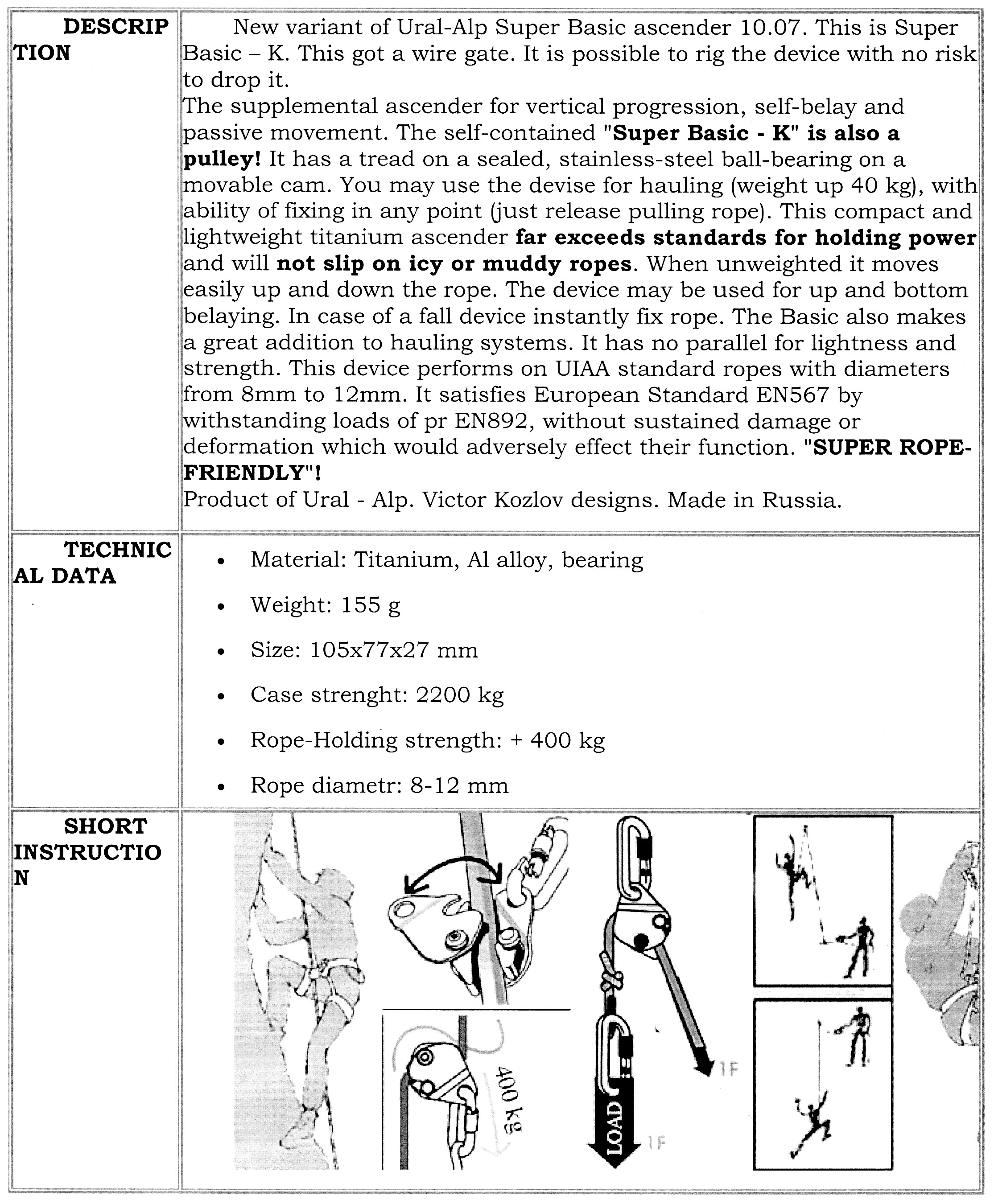 I acquired my 10.07M from Ural Sport in 2005.
I acquired my 10.07M from Ural Sport in 2005.
The Super Basic K 10.07M is 110 mm. tall, 67 mm. wide, 28 mm. thick, and weighs 156 g.
Take the 10.05M Basic K and replace the lever with the Super
Basic 10.07 lever, and you have the 10.07M
The front plate is stamped with a rectangle containing
"RUSSIA" and URAL-ALP." The outside of the rear
plate is stamped with "Made in Russia" and a rectangle
containing the words "KOZLOV DESIGNS." The inside of
the rear plate is stamped with "▲," "ROPE," "Ø10-12MM," "▼, and "BS-0." There may be another digit hidden behind the anvil.
I discussed the hook attachment with the 10.05M, and the pulley
with the 10.07.
[ Top
| Ural-Alp Al Basic 10.03
| Al Basic 10.03
| Basic 10.04
| Basic 10.05, v. A
| Basic 10.05, v. B
| Basic 10.05, v. C
| Basic 10.05, v. F
|
| Basic K
| Super Basic, v. A
| Super Basic, v. B
| Super Basic K
| Ural Alp Handled
| Ushba Handled, v. A
| Ushba Handled, v. B
| Return to Rocker-Arm Ascenders
| Ushba Handled, v. B
]
Ural-Alp Steel Basic 20.01
(#190)
Technical Details
I acquired my 20.01 from Ural Sport in 2005.
The Steel Basic 20.01 is 93 mm. tall, 75 mm. wide, 32 mm. thick, and weighs 308 g.
The 20.01 is functionally equivalent to the Basic, but all
parts are steel. The side plates are 2.9 mm. thick and painted
with a speckled gray paint. The remaining steel parts have a black
oxide finish. The actuating lever does not have lightening cutouts
on the left side The bolts are standard hex bolts, and the nuts
standard hex nuts.
The front plate is stamped with the the Ushba logo and "Ushba." .
The outside of the rear plate is stamped with a rectangle also
containing the words "KOZLOV DESIGNS" and below, "Made in RUSSIA." The inside
of the rear plate is stamped with "▲," "ROPE," "Ø10-13
MM," "▼," and "AB-04."
The 20.01 weighs 2 to 2.5 times what the other ascenders on
this page weigh, and steel rusts. Enough said: buy one of the
other models.
[ Top
| Ural-Alp Al Basic 10.03
| Al Basic 10.03
| Basic 10.04
| Basic 10.05, v. A
| Basic 10.05, v. B
| Basic 10.05, v. C
| Basic 10.05, v. D
| Basic 10.05, v. E
| Basic 10.05, v. F
|
| Basic K
| Super Basic, v. A
| Super Basic, v. B
| Super Basic K
| Steel Basic
| Ushba Handled, v. A
| Ushba Handled, v. B
| Return to Rocker-Arm Ascenders
| Ushba Handled, v. B
]
Ural Alp Handled
(#120)
Technical Details
I acquired my Ural Alp Basic 10.05 from John E. Weinel, Inc. in 1994.
The Ural Alp Basic 10.05 is 71 mm. tall, 86 mm. wide, 27 mm. thick, and weighs 126 g.
The frame is a roughly a right trapezoidal shaped piece of
stamped, engine-turned 3 mm. titanium. The wide side is at the
bottom.
A rounded cutout forms a handle on the vertical side.
The hand opening is 100 mm. high and 35 mm
wide. A rubberized handgrip encircles the vertical
side of the frame. The grip has four finger grooves. It is about
18 mm. thick in the center, narrowing to 14 mm. at top and bottom.
A 16 mm. hole through the bottom of the grip
and frame serves as the main sling attachment point.
The side opposite the grip supports the working parts, consisting
of a triangular grip lever, and anvil assembly. A swinging
side plate covers these. The lever is mounted at the lower outside
of the ascender. The lever is 59 mm. long, and pivots on a nylon bushing
and 7 mm. stainless steel bolt. A small, hidden spring forces the
lever toward the closed position. The fulcrum is offset so that
it lies 24 mm. from the lower end of the lever. The lever is 12 mm
thick. Both ends of the lever are rounded. The long side of the
lever rests against the standing rope. The shorter sides are machined
out to reduce weight. In use, the handle rotates and the standing
rope pulls the upper end of the lever outward. The lower end of
the lever moves inward and forces the standing rope against the
anvil, providing the friction needed for the ascender to hold. The lever axle is dripped out for much of its length to reduce weight.
The anvil appears to be nickel-plated aluminum. It is mounted
at the lowest point on the frame, near the handle opening with
one. It is made in two parts. The lower part is an irregular 4-sided block, 40 mm. long, 20 mm. high and 13.9 mm. thick. An 7 mm. titanium
bolt fastens the lower portion of the anvil to the frame, and
also provides an engagement groove for the swinging side plate.
A 5 mm. rivet secures the inner end of the anvil block. The face of the
anvil block is slightly dished where the lever presses the standing
rope against it. The lower anvil also
supports a 6.3 mm. spring-loaded button that engages a hole in the
swinging side plate to hold the plate closed. The upper anvil is an 18.6 mm. diameter, 13.8 mm. long cylinder cut on one side to form a V-shaped groove
with four -shaped teeth. These teeth are not
active in normal operation, but come into play when the ascender
acts in an inverted mode to be discussed later.
The swinging side plate is made of 2 mm. engine-turned titanium
sheet. It pivots on the same bolt and bushing as the lever. A
notch engages the grooves in the anvil bolt.
A 7 mm. hole accepts the spring-loaded anvil button. A small tab is folded outward to provide a finger
tab for operating the side plate.
A dogleg bend in the frame at the opposite side of the handle
opening aligns the grip with the center of the main rope. A
16 mm. hole in the frame near the post appears to be for weight
saving only
All bolts are punched twice so that the associated nuts cannot
come loose. There are no exposed sharp edges except for the anvil
teeth.
The side plate is stamped with "RUSSIA" and "URAL-ALP" inside a rounded rectangle. The inside of the frame is stamped with "PATENT" inside a rounded rectangle; a Sieg Heil icon;, "ROPE," "WIRE HAWSER, and "Ø8-13MM" inside a circle; and "N4-93" (mirror image N). The back of the frame is stamped
"TITANIUM EQUIPMENT" inside a rounded rectangle.
The
ascender came with Russian instructions that I cannot read, but the instructions for the Ushba handled ascender can be followed.
In low angle work - say, fixed lines in mountaineering - the ascender
will grip in either direction, so if the line above you is cut
and you fall, the ascender will still act to arrest the fall.
Considering how sharp the post teeth are, I'm reluctant to try
this on good rope. It’s not clear why the post teeth or V-groove
are needed. The Ushba handled ascender
instructions are silent on this point. I presume it is because
the fulcrum is not centered on the lever, and the designers felt
that the teeth were needed to provide more holding power when
the ascender is arresting a fall when the rope above the ascender
has broken.
The handle has a comfortable rubber grip, and for once, the
finger grooves are not obnoxious.
The ascender rotates as it is loaded, and looses 8 to 9 cm
on each step. This is a considerable loss, considering the number
of steps taken on a long climb. This alone would persuade me to
choose another ascender for vertical work.
The Ural-Alp evolved into the Ushba
handled ascender.
Serguei Khramtsov (of eBay’s Ural Sport store) sent me an email
with the following comment:
In my opinion, your descriptions for Ural-Alp’s
Ushba’s Handled and Basic ascenders and other ascenders based
on the same principle are not complete. Because it has no words
about using it on ice covered ropes. If you ask mountaineers
who ever climb by ice-covered rope they will tell you that "eccentric
cam" type ascenders became absolutely helpless in this situation.
Only some "eccentric cam" type ascenders with aggressive
teeth can grip the ice-covered rope. But they are not good for
a rope. But I'm sure that mountaineers who have Ushba’s ascenders
had no problem to climb by icy ropes.
I have not tried to use these ascenders on icy ropes, so
I cannot confirm their performance first-hand; however, I appreciate
the comment.
[ Top
| Ural-Alp Al Basic 10.03
| Al Basic 10.03
| Basic 10.04
| Basic 10.05, v. A
| Basic 10.05, v. B
| Basic 10.05, v. C
| Basic 10.05, v. D
| Basic 10.05, v. E
| Basic 10.05, v. F
|
| Basic K
| Super Basic, v. A
| Super Basic, v. B
| Super Basic K
| Steel Basic
| Ural Alp Handled
| Return to Rocker-Arm Ascenders
| Ushba Handled, v. B
]
Ushba Handled, Version A
(#144, 2273)
Technical Details
I acquired the left-hand ascender from Ushba Mountain Works
in 1999, and the right-hand ascender in 2000. I acquired another pair in 2017 as part of Bob Thrun’s collection.
The Ushba Handled, Version A is 151 mm. tall, 121 mm. wide, 33 mm. thick, and weighs 268 g.
The frame is a roughly a right trapezoidal shaped piece of
stamped, engine-turned 3 mm. titanium. The wide side is at the
bottom, and a bulge protrudes downward from the acute corner.
A rounded trapezoidal cutout forms a handle on the vertical side.
The hand opening is 100 mm. high, 48 mm. wide at the top and 35 mm
wide at the bottom. A rubberized handgrip encircles the vertical
side of the frame. The grip has four finger grooves. It is about
18 mm. thick in the center, narrowing to 14 mm. at top and bottom.
A slightly elongated 16 mm. hole through the bottom of the grip
and frame serves as the main sling attachment point.
The side opposite the grip supports the working parts, consisting
of a triangular grip lever, and anvil, and a post. A swinging
side plate covers these. The lever is mounted at the lower outside
of the ascender. The lever is 61 mm. long, and pivots on a nylon bushing
and 5 mm. stainless steel bolt. A small, hidden spring forces the
lever toward the closed position. The fulcrum is offset so that
it lies 24 mm. from the lower end of the lever. The lever is 13.5 mm
thick. Both ends of the lever are rounded. The long side of the
lever rests against the standing rope. The shorter sides are machined
out to reduce weight. In use, the handle rotates and the standing
rope pulls the upper end of the lever outward. The lower end of
the lever moves inward and forces the standing rope against the
anvil, providing the friction needed for the ascender to hold.
The anvil appears to be nickel-plated aluminum. It is mounted
at the lowest point on the frame, near the handle opening with
one. It is 50 mm. high, 20 mm. wide and 14.5 mm. thick. An 8 mm. titanium
bolt fastens the lower portion of the anvil to the frame, and
also provides an engagement groove for the swinging side plate.
A 5 mm. rivet secures the upper end of the anvil. The face of the
anvil is slightly dished where the lever presses the standing
rope against it. The upper side of the anvil has a V-shaped groove
with six z-shaped teeth cut on each side. These teeth are not
active in normal operation, but come into play when the ascender
acts in an inverted mode to be discussed later. The anvil also
supports a 10 mm. spring-loaded button that engages a hole in the
swinging side plate to hold the plate closed.
The post is mounted above the anvil. It is 12 mm. in diameter,
and features an groove for engaging the swinging side plate. The
post serves no function for normal ascending, but comes into play
during rappelling and when the ascender is used in the inverted
mode.
The swinging side plate is made of 2 mm. engine-turned titanium
sheet. It pivots on the same bolt and bushing as the lever. Two
notches engage the grooves in the anvil bolt and post, respectively.
An 11 mm. hole accepts the spring-loaded anvil button. The inner
portion of a c-shaped cut is folded outward to provide a finger
tab for operating the side plate.
A dogleg bend in the frame at the opposite side of the handle
opening aligns the grip with the center of the main rope. Three
16 mm. holes in the frame near the post appear to be for weight
saving only
All bolts are punched twice so that the associated nuts cannot
come loose. There are no exposed sharp edges except for the anvil
teeth.
The side plate is stamped with "Ushba" and the Ushba
logo. The inside of the frame is stamped with a symbolic person
with one arm raised, a circle with "ROPE" and "8-13 mm" inside, arrowheads pointing up and down the standing rope axis, and "И2-9,"
partially obscured by the anvil. The back of the frame is stamped
"Patent," "KOZLOV DESIGNS" (the "V" is covered by the post nut),
and "Made in RUSSIA."
The
Ushba handled ascender is an updated Version of the Ural
Alp handled ascender.
The ascender will grip in either direction, so if the line
above you is cut and you fall, the ascender will still act to
arrest the fall. Considering how sharp the teeth are, I'm reluctant
to try this on good rope. The manufacturer’s literature doesn't
guarantee that this will always work, but with most other ascenders
there is no chance at all. I think that this feature is probably
most useful in mountaineering, where fixed lines are common, snow
anchors are less secure than the normal rock climbing or caving
anchors, and the slope is not vertical.
It’s not clear why the post teeth or V-groove are needed, and
the instructions don't say, but I presume it is because the fulcrum
is not centered on the lever, and the designers felt that the
teeth were needed to provide more holding power when the ascender
was used in the inverted manner (i.e., arresting a fall when the
rope above the ascender has broken). I have noticed that when
using 11 mm. rope in the inverted manner, the lever forces the
rope against the post, while on 9 mm. rope, the lever forces the
rope against the anvil. A 10 mm. rope (give or take) can sometimes
jam between the lever and post, but a simple tug usually releases
the jam.
The Ushba ascender attaches securely and is unlikely to accidentally
come off the rope. On the other hand, the Ushba ascender is difficult
to remove or attach with one hand. This makes such common caving
maneuvers as passing rebelays, switching ropes, passing knots
and doing changeovers more time-consuming.
The handle has a comfortable rubber grip, and for once, the
finger grooves are not obnoxious. The ascender rotates as it is
loaded. When loaded, the grip is horizontal. Pulling on it is
like pulling on a chin-up bar: the wrist doesn't need to be cocked
like it is with most handled ascenders. If you use a lot of arm
strength while ascending, you may like this feature (e.g., ascending
in aiders, where efficiency basically sucks compared to any decent
caving rig). The down side is that the rotation causes one to
lose 8 to 9 cm on each step. This is a considerable loss, considering
the number of steps taken on a long climb. This alone would persuade
me to choose another ascender for vertical work.
The ascender’s rotation is an essential factor in getting the
lever to turn and grip the rope. Because of this, I was concerned
that the top climber in a tandem pair might find that the ascender
would not grip. I decided to try to quantify this by hanging weights
underneath me on a free-hanging rope. I weigh 88 kg. My results
so far are summarized below:
Weight
Hanging Below |
Effect,
11 mm. BlueWater |
Effect,
13 mm. PMI |
| 20 kg |
Set & held well. |
Set & held well. |
| 40 kg |
Set & held after
some initial slippage . |
Set & held well.
Started to feel "loose." |
| 55 kg |
Set & held after some initial
slippage. |
Set & held after some initial
slippage. |
| 70 kg |
Set & held after
some initial slippage. Hand-setting desirable. |
Set & held after
some initial slippage |
I ran out of weights the day I did these tests. These limited
tests show that the concern was reasonable, but not to be exaggerated,
since the ascender always held if given an initial set by hand.
Even when it slipped, the distance was less than a centimeter.
Applying ones weight slowly increased the slippage, while a good
solid step onto the ascender eliminated it. The fat rope held
better because its tight fit in the ascender created more initial
friction than the lever spring could by itself. I didn't test
a 9 mm. rope because I feel that is too thin for tandem climbing,
but I suspect the ascender would slip slightly easier than on
thicker ropes.
I asked Ushba Mountain Works for test results on the ascender, and was told
that on 11 mm. rope, it could support 2200 to 2400 lbs (9.8 to
10.6 kN) before rope damage occurs.
The post allows one to use the ascender as a descender. I'm
not particularly impressed with this capability, preferring to
use a dedicated descender (in an emergency, a carabiner brake
rappel) instead of running the rope over the edge of the sheet-metal
frame. On typical dirty caving ropes, sand could wear a sharp
edge on the frame that could easily cut the rappel rope. At least
the frame is Titanium and will resist wear fairly well, aluminum
certainly wouldn't last.
[ Top
| Ural-Alp Al Basic 10.03
| Al Basic 10.03
| Basic 10.04
| Basic 10.05, v. A
| Basic 10.05, v. B
| Basic 10.05, v. C
| Basic 10.05, v. D
| Basic 10.05, v. E
| Basic 10.05, v. F
|
| Basic K
| Super Basic, v. A
| Super Basic, v. B
| Super Basic K
| Steel Basic
| Ural Alp Handled
| Return to Rocker-Arm Ascenders
| Ushba Handled, v. A
]
Ushba Handled, Version B
(#3516)
Technical Details
I acquired this left-hand ascender from Steve Lambrick in 2022.
This ascender is 151 mm. tall, 121 mm. wide, 33 mm. thick, and weighs 274 g.
This ascender is materially and mechanically identical to Version A
The side plate is stamped with "Ushba" and the Ushba
logo. The inside of the frame is stamped with "PATENTED" inside a round-cornered rectangle, a circle with "ROPE", "WIRE HAWSER," "Ø8-13 mm" inside, arrowheads pointing up and down the standing rope axis, and "И2-9." The back of the frame is stamped "KOZLOV DESIGNS" (the "V" is covered by the post nut),
and "Made in RUSSIA."
The stamped markings are the only difference between this version and Version A
[ Top
| Ural-Alp Al Basic 10.03
| Al Basic 10.03
| Basic 10.04
| Basic 10.05, v. A
| Basic 10.05, v. B
| Basic 10.05, v. C
| Basic 10.05, v. D
| Basic 10.05, v. E
| Basic 10.05, v. F
|
| Basic K
| Super Basic, v. A
| Super Basic, v. B
| Super Basic K
| Steel Basic
| Ural Alp Handled
| Ushba Handled, v. A
| Ushba Handled, v. B
]



